Best Top Handle Chainsaw | Head-to-Head | 2023
Best Battery-Powered Top Handle Chainsaw Testing

This Head-2-Head will take a look at the best battery top-handle chainsaw for 2023. Battery technology has evolved to become arguably the king of outdoor power equipment. But does it measure up to what dedicated Pros need? In 2020 the ToolBoxBuzz crew hosted our first Best Cordless Chainsaw Head-2-Head where we evaluated twelve traditional rear handle saws. During that testing it was clear that a battery saw was an excellent option for a homeowner or DIYer, but not for full-time use in the forestry and tree care industry.
Fast forward to 2023 and the battery tool industry has continued to evolve. Additionally, the pro arborist and landscaping trades have seen an increased demand for pro-grade battery offerings. Many communities and even some states, like California, are moving to ban gas-powered OPE altogether. Bearing all this in mind, the TBB Crew set out to find out who makes the best battery top-handle chainsaw.
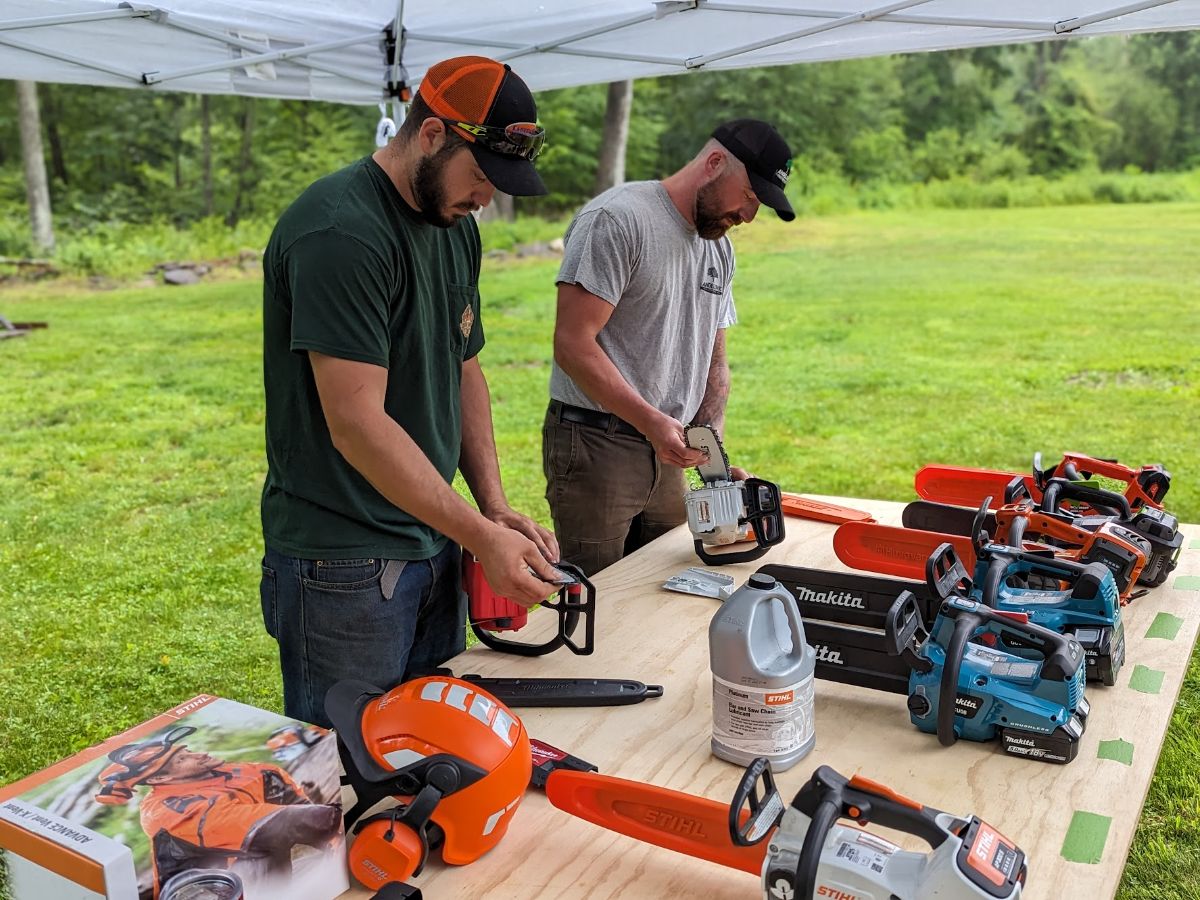
Top-handle chainsaws are often commonly referred to as climbing saws or bucket saws. They are designed for in-tree use by trained climbers or when working from a bucket truck in the air. These environments require the user to make cuts at adverse angles or from overhead or unsupported positions. They are often hung from the belt harnesses worn by arborists when climbing trees for takedown work. These unique demands require a saw to be compact and robust and move the handle location to the top of the saw to scale down the overall length.
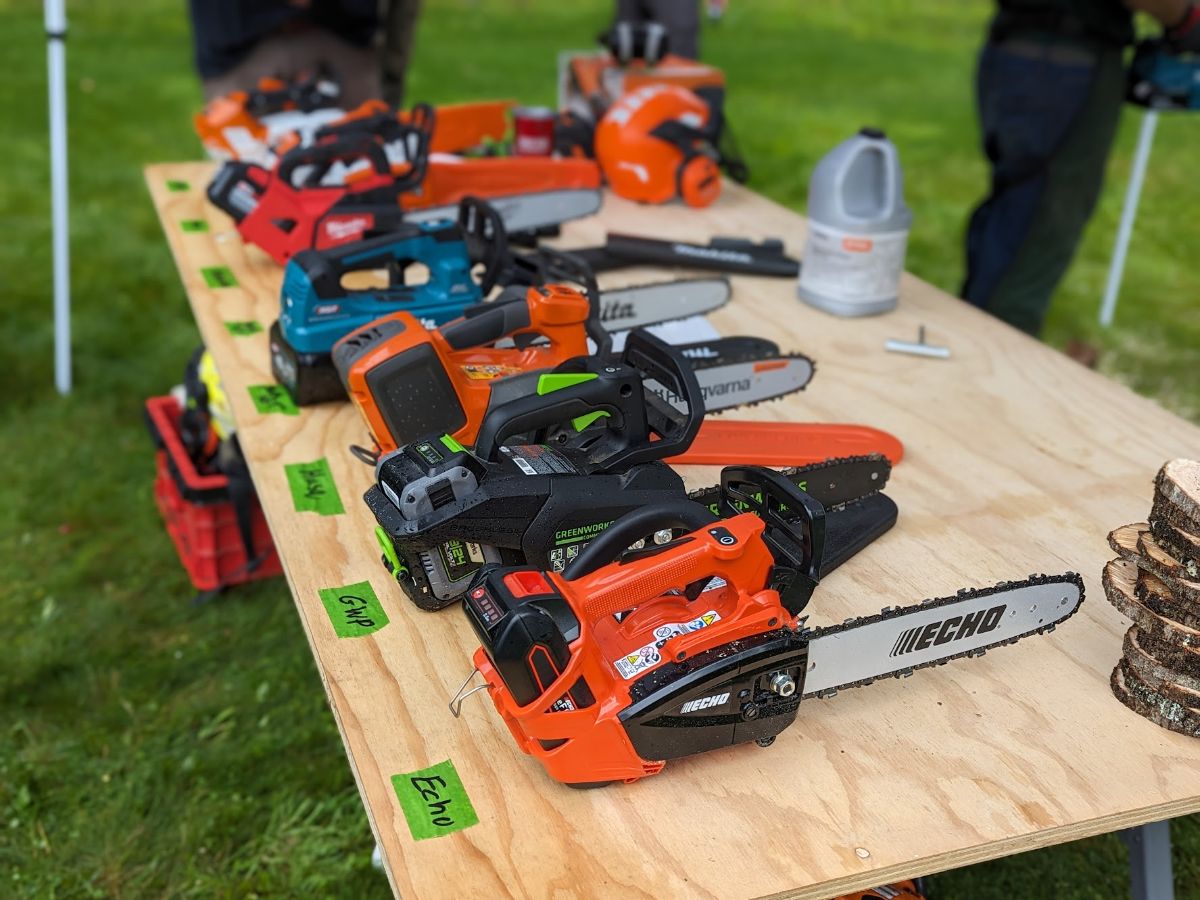
Pro User Feedback
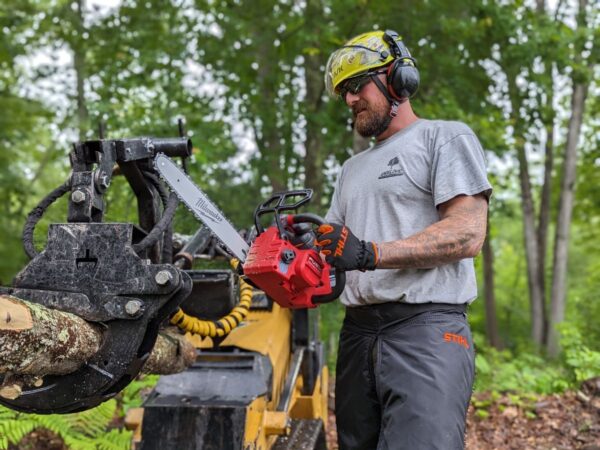
Scott Angelovic of Angelovic Tree Service, LLC.
Pro-user feedback is something we pride ourselves on at ToolBoxBuzz. In order to ensure that our testing protocols catered to tree care pros, we enlisted some local help. Our tests were conducted in Oxford, Connecticut by crew member Wes Bartosik. Additionally, Wes reached out to his friend Scott Angelovic of Angelovic Tree Sevice LLC. Scott is a long-time friend of Wes and a local business owner. Scott provided invaluable feedback on how each of our saws stacked up for pro use.
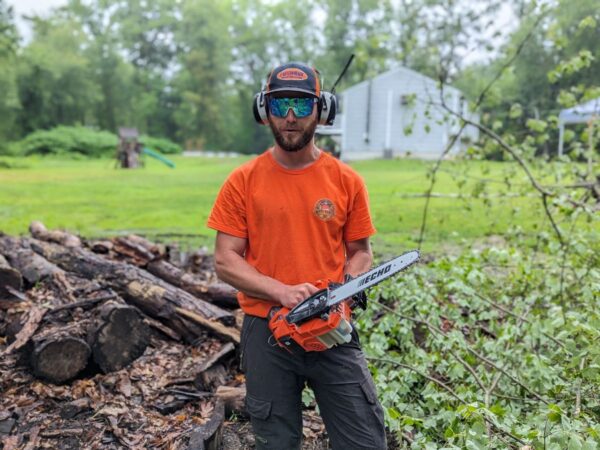
Jake Pollak better known as @DudeRanchDIY
ToolBoxBuzz was also fortunate enough to work with Jake Pollak of @DudeRanchDIY for the first time on this project. Jake is an arborist by trade but also sells firewood and operates his own Youtube channel showcasing his firewood operation and equipment as well as arborist and chainsaw-related content. Jake is another Connecticut native and was able to provide us with some excellent feedback on the saws. Check out Jake’s YouTube, Facebook, and Instagram accounts where he cross-posted a lot of the content we worked on together.
Testing Criteria

In order to keep the sample pool as consistent as possible, we developed a set of selection criteria. First and foremost, the saw must be a purpose-built arborist saw designed for professional tree work. There are several saws on the market that happen to have a handle on top but are not tailored to professionals in any other way. Next, we limited the bar length to between 12″and 14″. Some models that were sent by manufacturers had their OEM bars swapped out to the proper length for testing. While we could not narrow down the pitch or gauge any further amongst samples, the bar lengths were kept consistent. Finally, we limited the battery pack Ah size to the kitted offerings from each manufacturer. Some of our manufacturers offer their saws as an a la carte system with multiple chargers and battery offerings (such as Husqvarna and Stihl). For these manufacturers, we selected the recommended battery offering for the tool.

The above-mentioned criteria provided us with a sample size of eight saws from six manufacturers. Makita and Stihl both had two models included in the testing. Makita with their legacy 36V 18V LXT X2 saw as well as the new 40V Max XGT and Stihl with their legacy pruning saw as well as their newest offering.
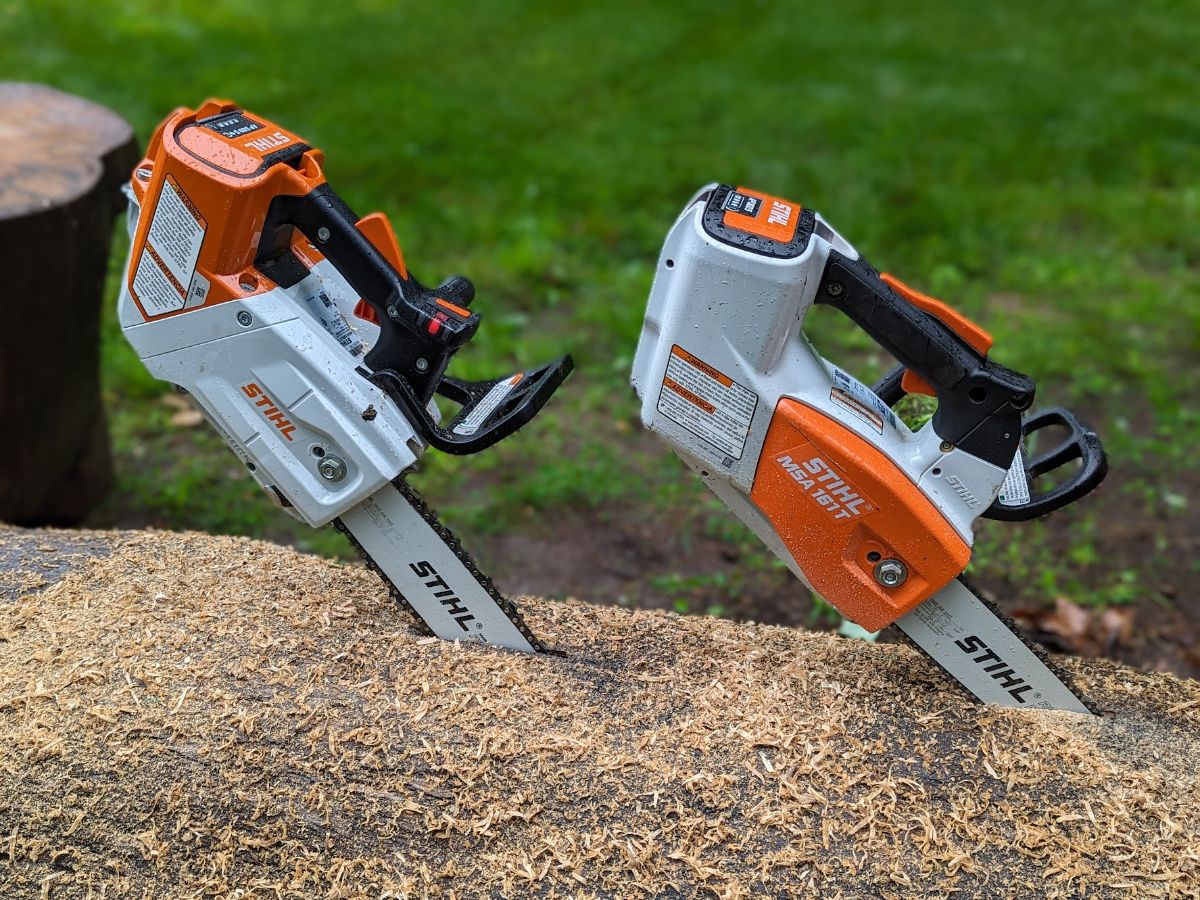
Saw Lineup
Echo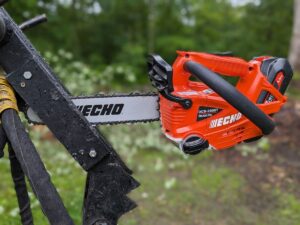
- Model: DCS-2500T
- Bare Tool Weight: 3.84 Lbs.
- Battery Platform: 56V eFORCE
- Battery Tested: 2.5 Ah
- Manual Adjustable Oiler
- Bar Length: 12″
- Chain Pitch: 3/8″ Low Profile
- Chain Gauge: 0.050″
- Tool Warranty: 5 Year Consumer / 2 Year Commercial
- Battery Warranty: 2 Year Consumer / 2 Year Commercial
Greenworks Commercial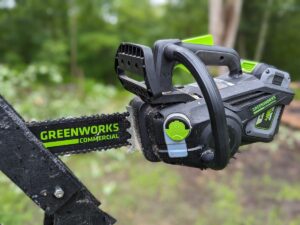
- Model: 48TH12
- Bare Tool Weight: 6.10 Lbs.
- Battery Platform: 48V DualVolt
- Battery Tested: 4.0 Ah
- Automatic Oiler
- Bar Length: 12″
- Chain Pitch: 3/8″
- Chain Gauge: 0.050″
- Tool Warranty: 2 Year Limited
- Battery Warranty: 2 Year Limited
Husqvarna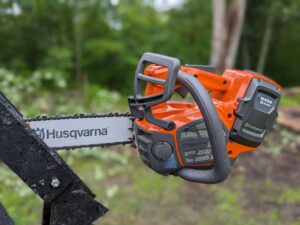
- Model: T540i XP
- Bare Tool Weight: 5.66 Lbs.
- Battery Platform: 40V
- Battery Tested: Bi200X 5.2 Ah
- Manual Adjustable Oiler
- Bar Length: 12″, 14″,16″
- Chain Pitch: 0.325″ Mini
- Chain Gauge: 0.043″
- Tool Warranty: 3 Year Consumer / 2 Year Commercial
- Battery Warranty: 3 Year Consumer / 2 Year Commercial
Makita 36V LXT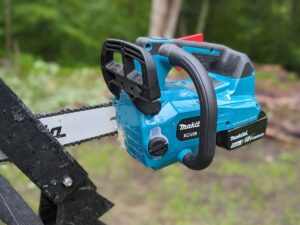
- Model: XCU08
- Bare Tool Weight: 6.28 Lbs.
- Battery Platform: (2x) 18V LXT
- Battery Tested: (2X) 5.0 Ah
- Manual Adjustable Oiler
- Bar Length: 14″, 16″
- Chain Pitch: 3/8″ Low Profile
- Chain Gauge: 0.043″
- Tool Warranty: 3 Year Limited
- Battery Warranty: 3 Year Limited
Makita 40V XGT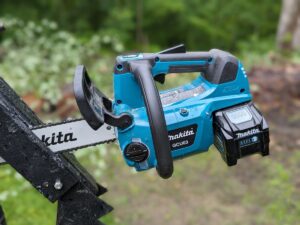
- Model: GCU03Z
- Bare Tool Weight: 5.74 Lbs.
- Battery Platform: 40V Max XGT
- Battery Tested: 4.0 Ah
- Manual Adjustable Oiler
- Bar Length: 12″, 14″, 16″
- Chain Pitch: 3/8″ Low Profile
- Chain Gauge: 0.043″
- Tool Warranty: 3 Year Limited
- Battery Warranty: 3 Year Limited
Milwaukee M18 FUEL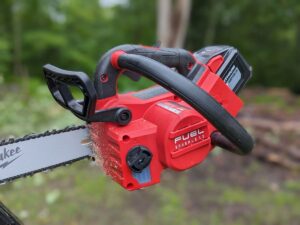
- Model: 2826-22T
- Bare Tool Weight: 7.30 Lbs.
- Battery Platform: M18 FUEL
- Battery Tested: 8.0 Ah
- Manual Adjustable Oiler
- Bar Length: 12″, 14″
- Chain Pitch: 3/8″ Low Profile
- Chain Gauge: 0.043″
- Tool Warranty: 5 Year Limited
- Battery Warranty: 3 Year Limited
Stihl MSA 161T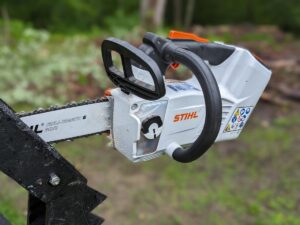
- Model: MSA 161T
- Bare Tool Weight: 4.86 Lbs.
- Battery Platform: 36V AP Series
- Battery Tested: AP 300S 7.2 Ah
- Manual Adjustable Oiler
- Bar Length: 12″
- Chain Pitch: 1/4″ PICCO Micro 3
- Chain Gauge: 0.043″
- Tool Warranty: 3 Year Consumer / 2 Year Commercial
- Battery Warranty: 3 Year Consumer / 2 Year Commercial
Stihl MSA 220TC-O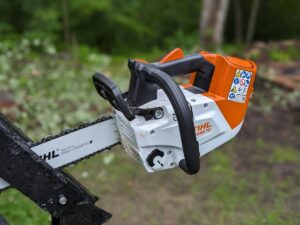
- Model: MSA 220TC-O
- Bare Tool Weight: 6.10 Lbs.
- Battery Platform: 36V AP Series
- Battery Tested: AP 500S 9.4 Ah
- Manual Adjustable Oiler
- Bar Length: 14″
- Chain Pitch: 3/8″ PICCO
- Chain Gauge: 0.050″
- Tool Warranty: 2 Year Commercial Only
- Battery Warranty: 3 Year Consumer / 2 Year Commercial
Testing Criteria
Our saws were evaluated and ranked based on the following categories;
- Ability to Stall Out
- Small Diameter Speed Cut Testing
- Large Diameter Speed Cut Testing
- Weight
- Decibel Output
- Price
- Features
- Ergonomics
Based upon this information we named a best overall winner as well as a best value winner.
Safety Considerations
Chainsaws are an inherently dangerous tool by design. According to the US Consumer Product Safety Commission, there were 28,859 chainsaw-related accidents in 2020. The majority of those accidents (11,630) were to users’ legs. Bearing this in mind proper safety gear was mandatory for our testing crew. Each test cutter was required to wear safety toe boots, leg protection, as well as eye protection.
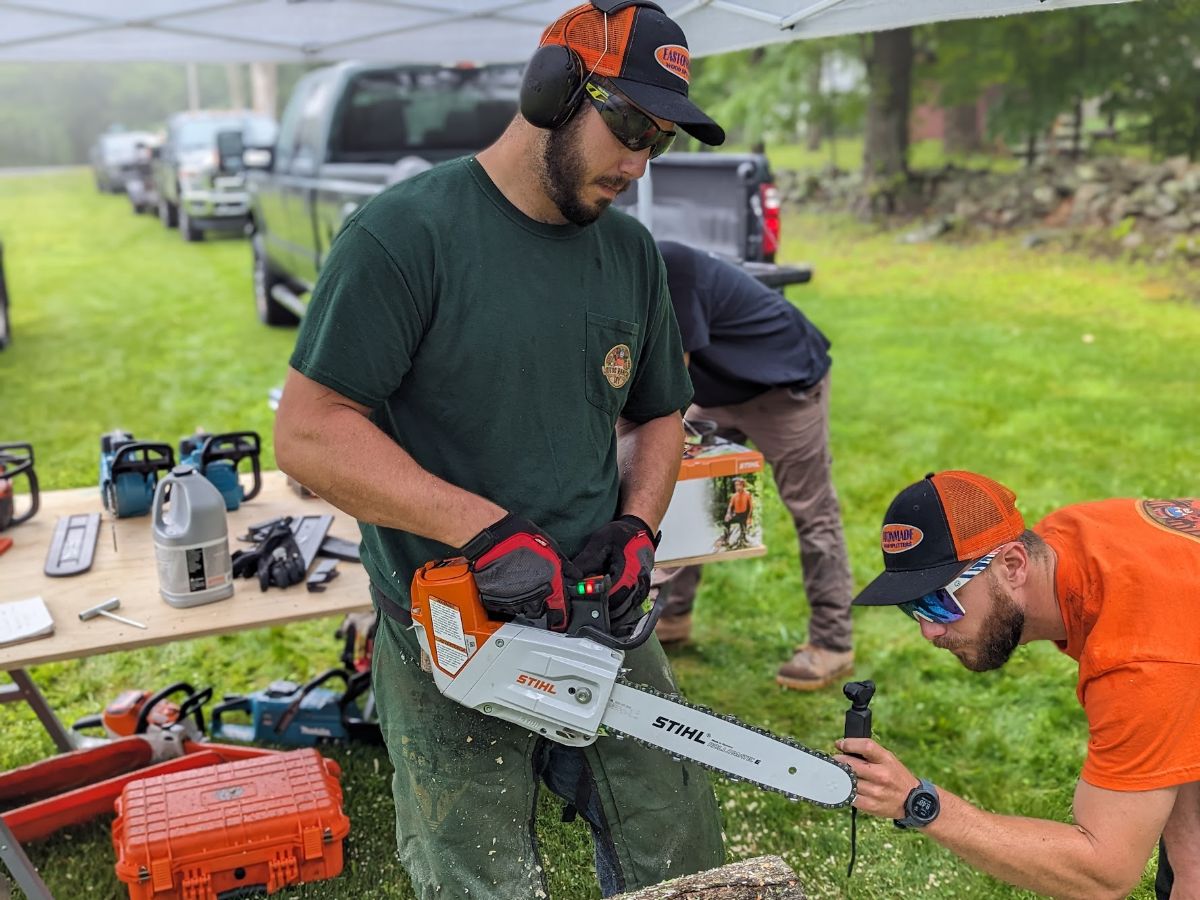
The ToolBoxBuzz crew strongly recommends any user interested in purchasing or working with a chainsaw invest in some quality protective gear. It is a simple initial investment that can save your life.
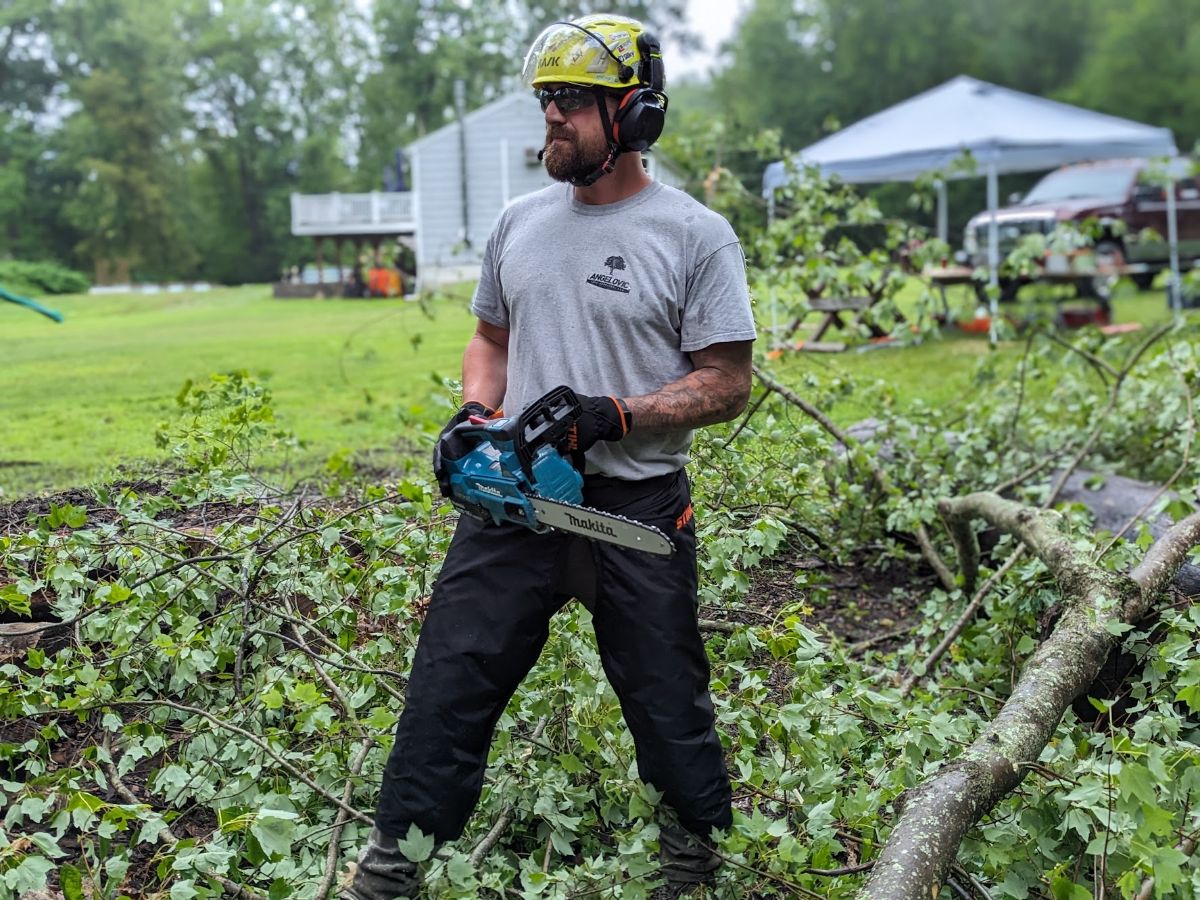
Ability to Stall Out
Before beginning our performance testing, we wanted to measure the ability of the user to stall out the saw during a cut. Traditionally a pro-grade gas saw can be “leaned into” when cutting to push through tough material, pinching forces of the wood, or overcome a slightly dull chain. Battery-powered saws are far more temperamental and less forgiving of the user levering them during use. Many manufacturers include overload protections in their battery tools to shut the saw down if the motor or the battery is being overworked. While this is a great idea in theory to protect the tool, it can be problematic for pros in the field.
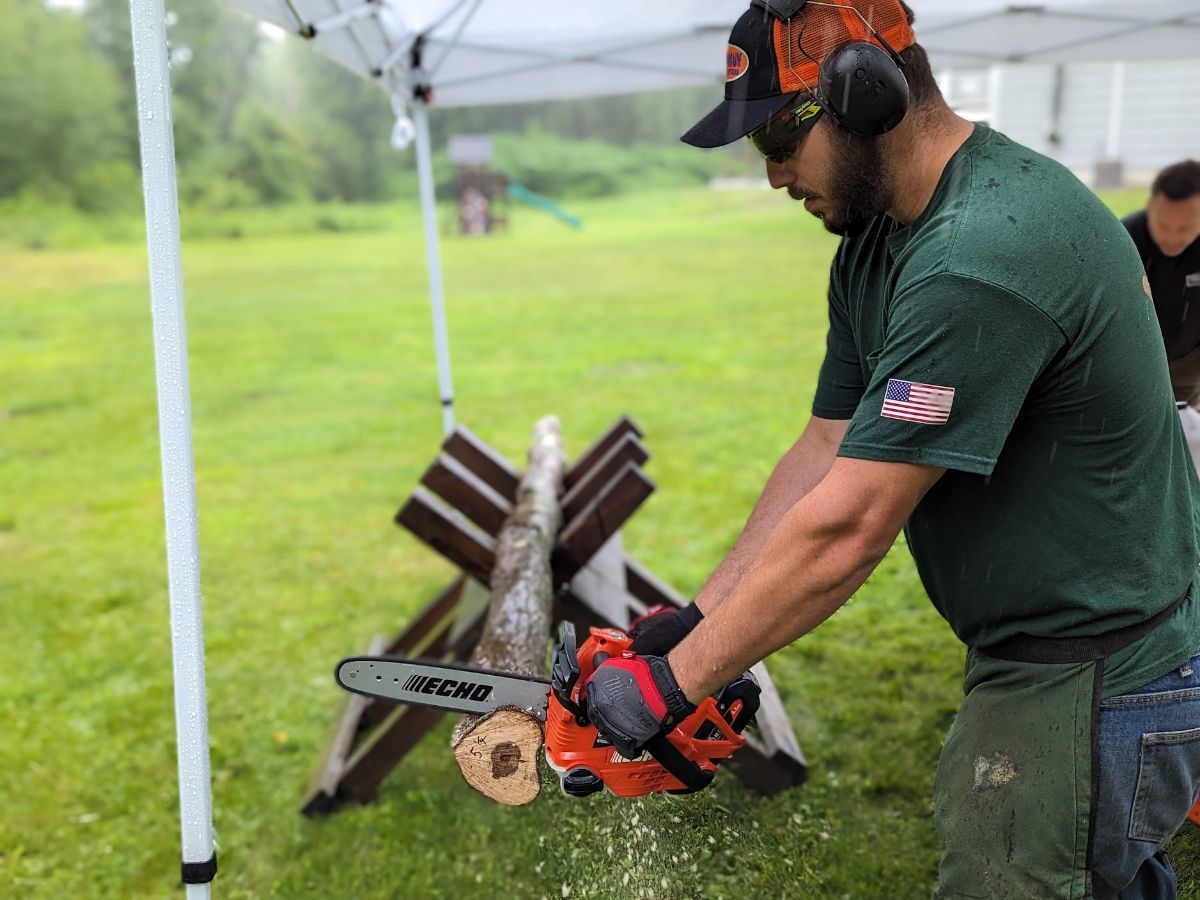
An arborist may be suspended in the air making an intricate hinge cut on a limb. At that moment, the user needs the saw to be able to power through and not bog down or stall out completely and need to be reset. Based upon this we set up a testing rig using a section of maple log. The test cutter was then instructed to make a crosscut while burying the saw to the nose and leaning into the cut. The test cutter was also instructed to apply the same amount of force each time in order to cause the saws to stall out.
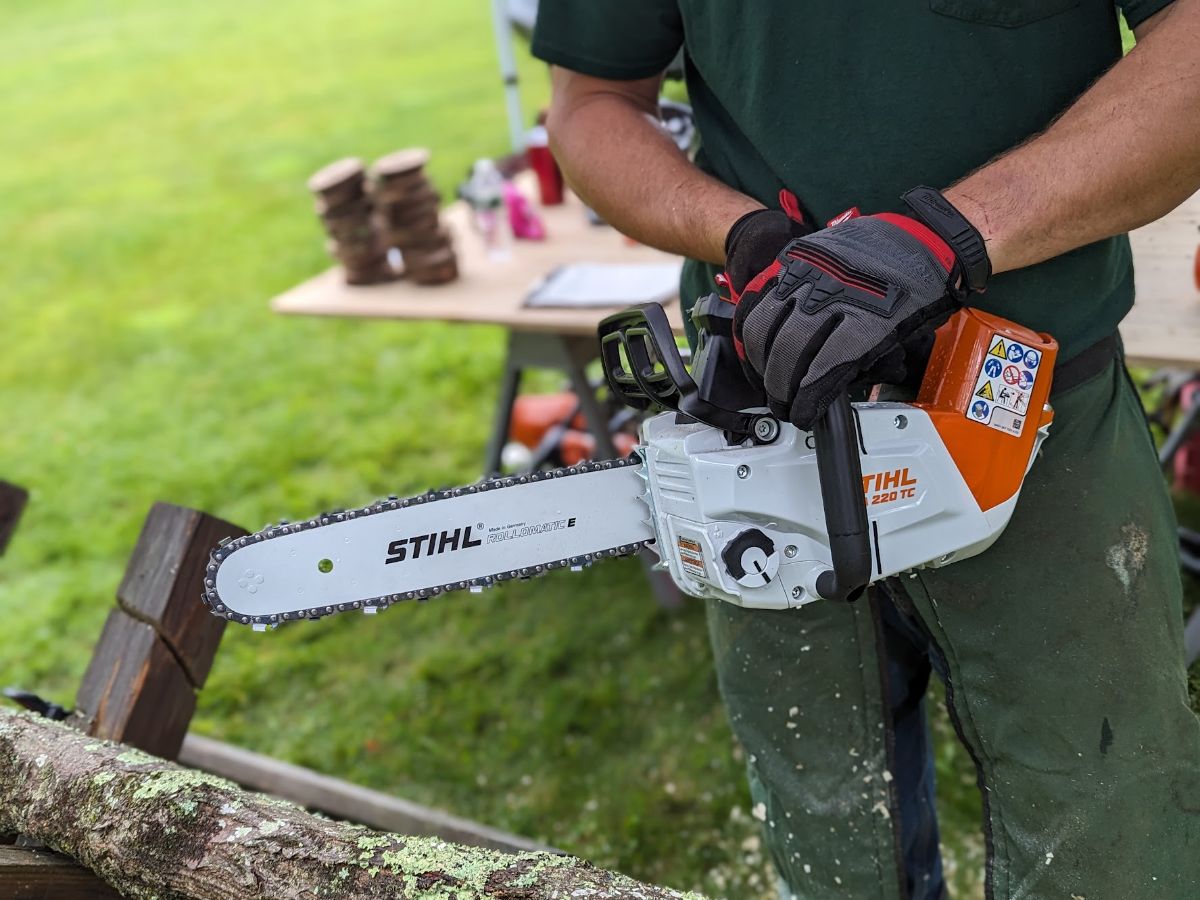
The Two best performers in this test were the Milwaukee and the Stihl MSA220TC. Our test cutter described both as “Beastly” and was unable to stall them out in the test log. Both saws provided outstanding consistent power throughout the cut. In second place was the Greenworks saw, which slowed during the test but continued cutting while being pushed through the cut. All three of these saws demonstrated an excellent low-end torque band that is ideal for demanding cutting tasks.
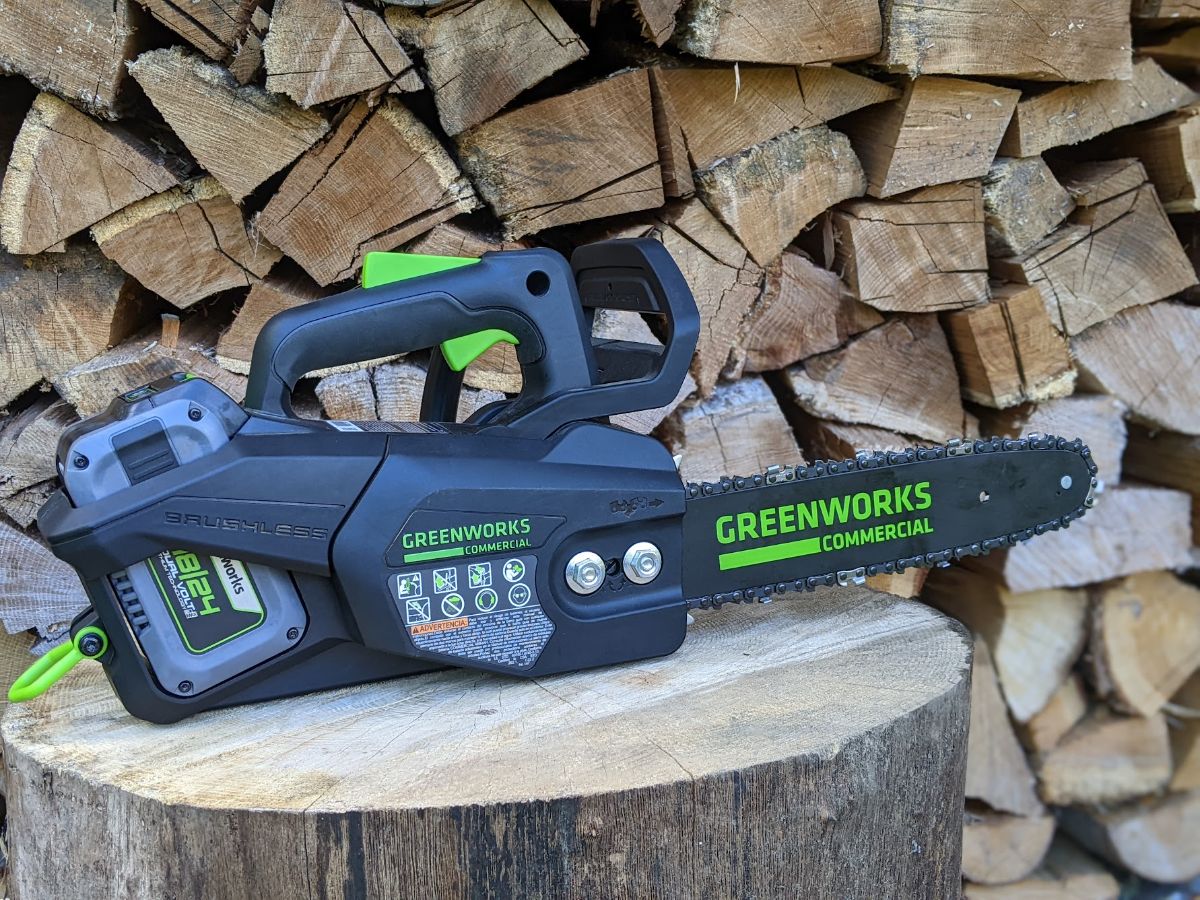
The Husqvarna and smaller Stihl MSA161T were our next best performers, stalling out only once the bar was at a depth consistent with the full width of the bar. Both Makita saws stalled out once the saw bar reached approximately half the width of the bar into the cut. Once this occurred, both saws had to be lifted up and then re-engaged to begin cutting again. The Makita XGT then stalled a second time before completing the cut. It seemed to our test crew that the Makitas were stalling in order to preserve the electronics, but this additional stop/start represents wasted time and productivity for professional users.
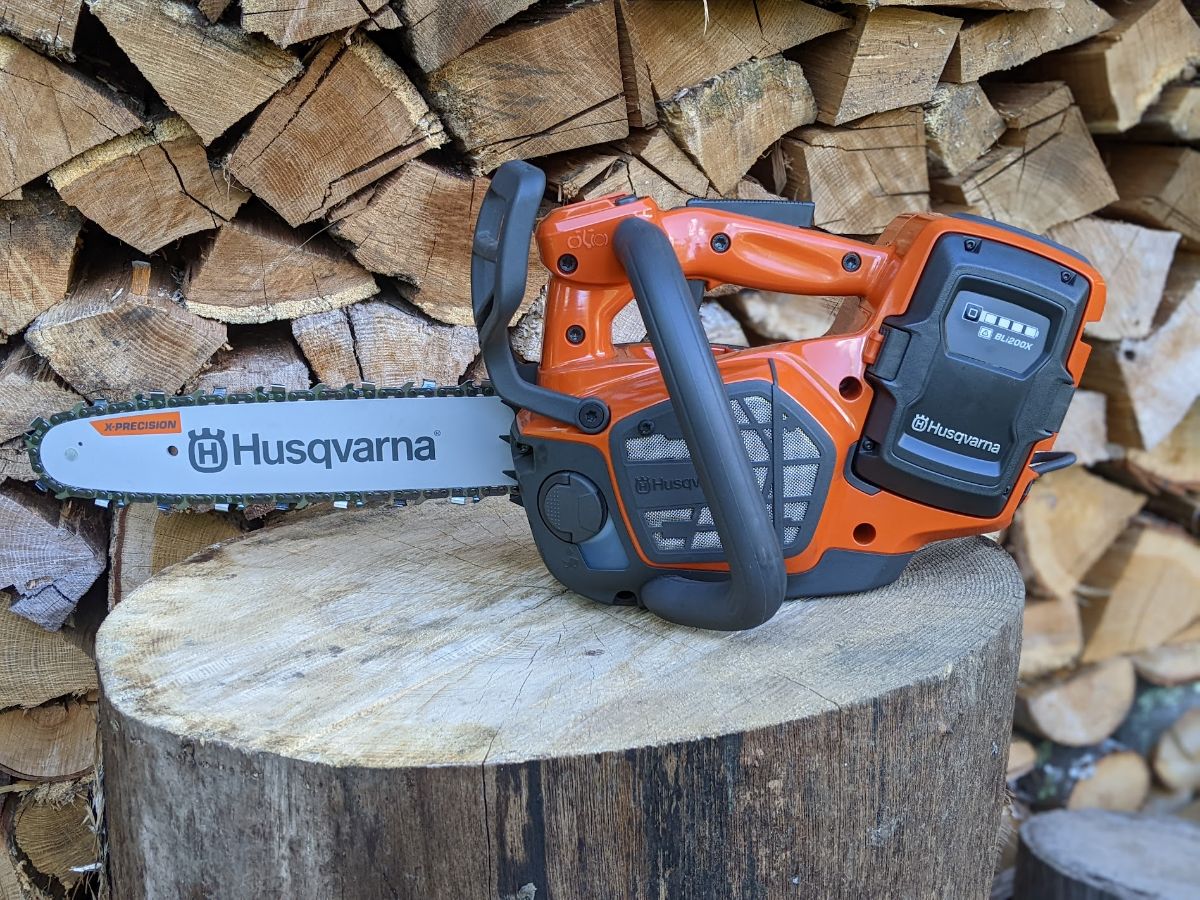
The Echo struggled the most in this test. The saw stopped multiple times and struggled to perform when being leaned on by our cutter. The Echo is also the smallest saw we tested and appears to be ideally suited for cutting smaller-diameter limbs or pruning work. Our test crew all agreed that the saws with larger full-size chains were preferable for commercial work and that reset buttons belong in video games and not on chainsaws.
Speed Cut Testing
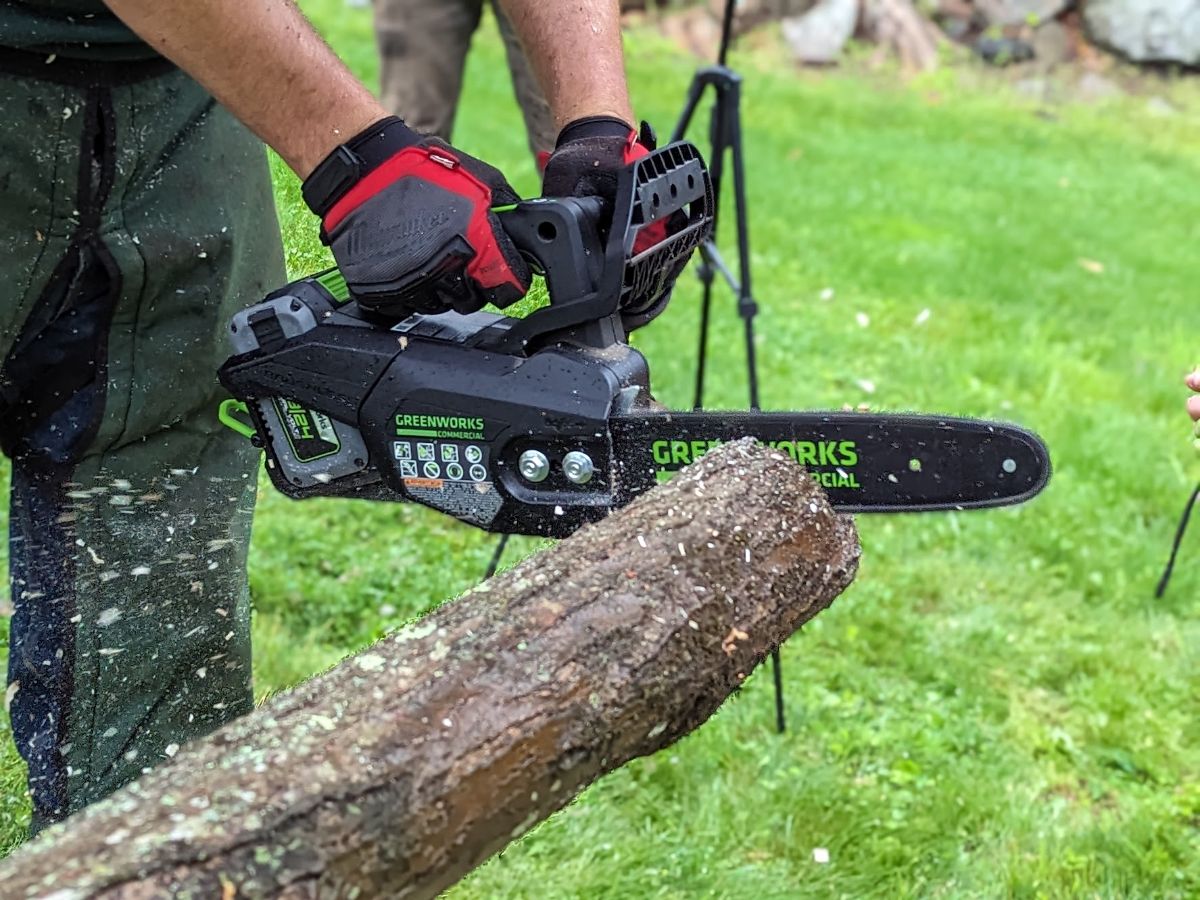
In order to determine our fastest cutter amongst the sample group, we designed two speed-cutting tests. The first was a smaller diameter cut to simulate a limbing or pruning job and the second was a larger diameter cut to simulate a full takedown job. For both tests, we used a green hardwood log from a tree species native to New England. We focused on green wood with this H2H in order to simulate the conditions that pros would encounter in the field. To keep it as green as possible, we dropped some trees on the day of testing!
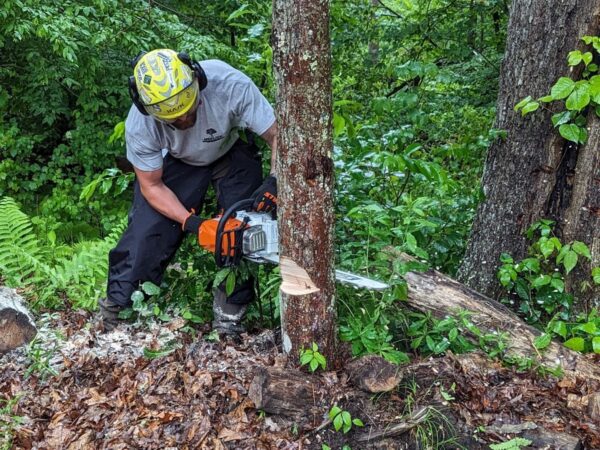
Scott using a Stihl MS400 to drop our test log tree.
Both tests were performed on sugar maple logs. Maple was selected as a medium-grade hardwood to offer a compromise between some harder species like oak which is plentiful in the Northeast and some of the pine species that are common on the West Coast. The Janka scale, which is the industry standard for hardness, lists sugar maple at approximately 1,450 Lb./Ft. The smaller diameter piece had an average measured diameter of 4.87″ and the larger diameter piece averaged at 7.75″.
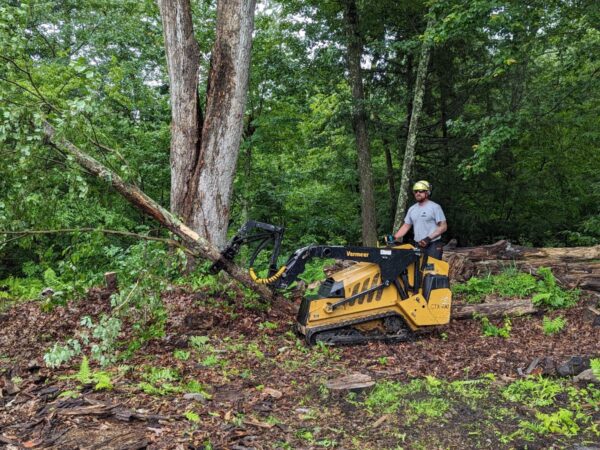
Moving our test log into position with a Vermeer mini-skid machine with a hydraulic grapple.
The test cut pieces were strapped securely to a log stand and the same test cutter performed the cuts with all eight saws. The instructions for the crew member were to guide the saw through the cut without leaning into it and allow gravity and the weight of the saw to do the work. For the smaller diameter test (T1), the cutter performed a down, up, and down cut to make a total of three cookies. The larger diameter test (T2) was limited to a down and up only in order to prevent stall out or thermal overload. This was the first test performed; all eight saws had fresh factory sharp chains.
Small Diameter Speed Cut T1
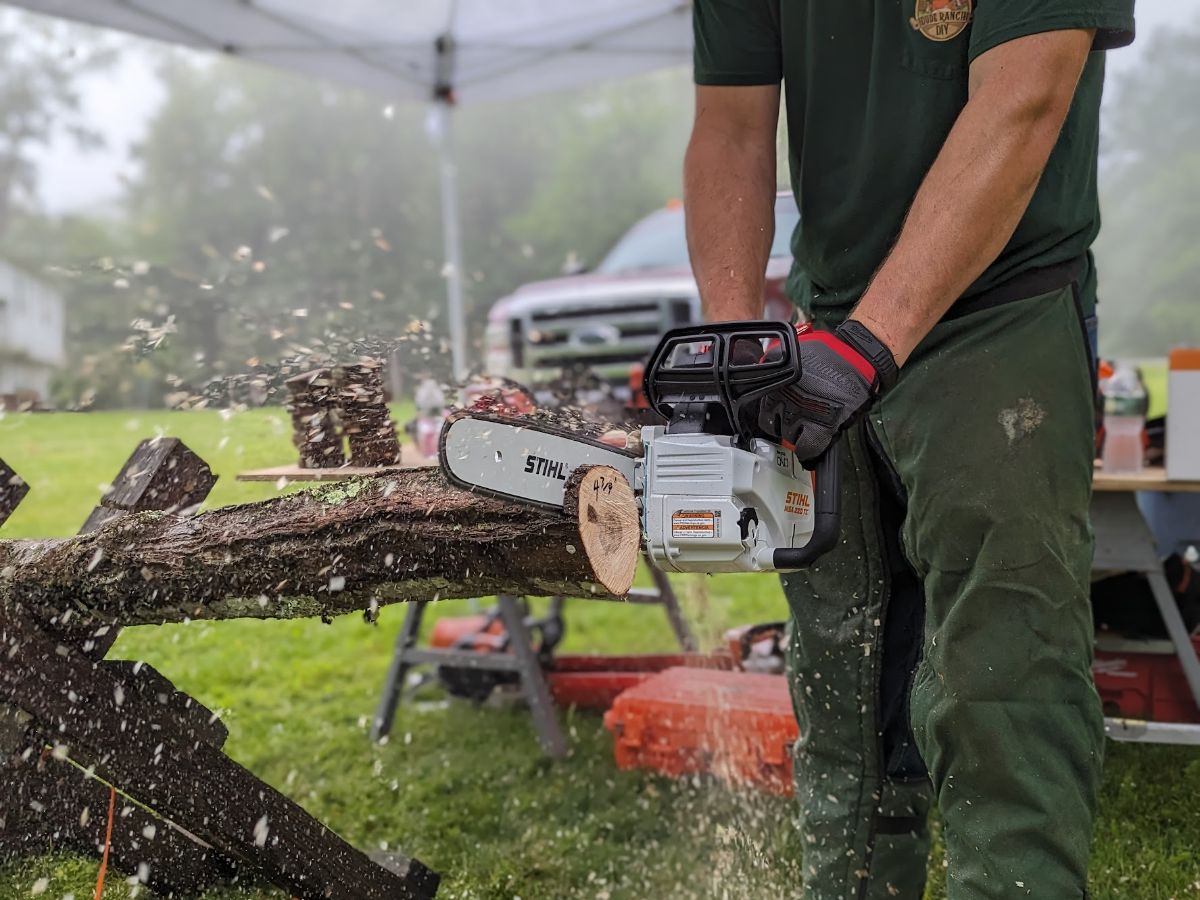
The winner of T1 was the Stihl MSA220 at 8.47 seconds, finishing almost three seconds faster than the runner-up. Milwaukee came in second at 11.10 seconds and Husqvarna in third at 11.56 seconds. The slowest cutter for T1 was the Echo at 23.35 seconds.
Larger Diameter Speed Cut T2
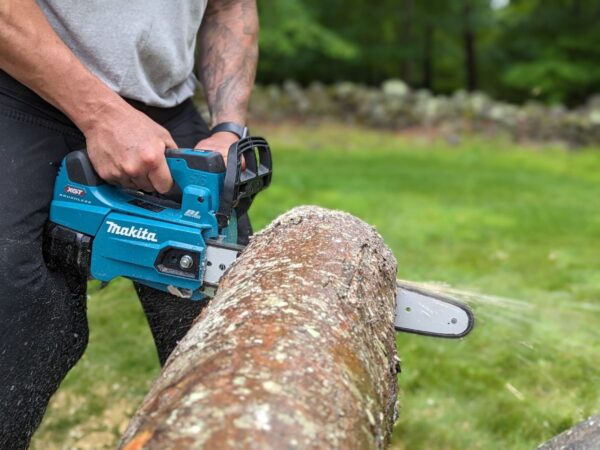
The Makita XGT saw powering through our larger diameter speed cut test.
The winner of T2 was the Stihl MSA 220 at 10.97 seconds. T2 showed the Makita XGT rising to second place at 11.59 seconds and Husqvarna beating out Milwaukee for the number three spot by 0.01 seconds. The slowest cutter for T2 was the Echo again at 39.29 seconds.
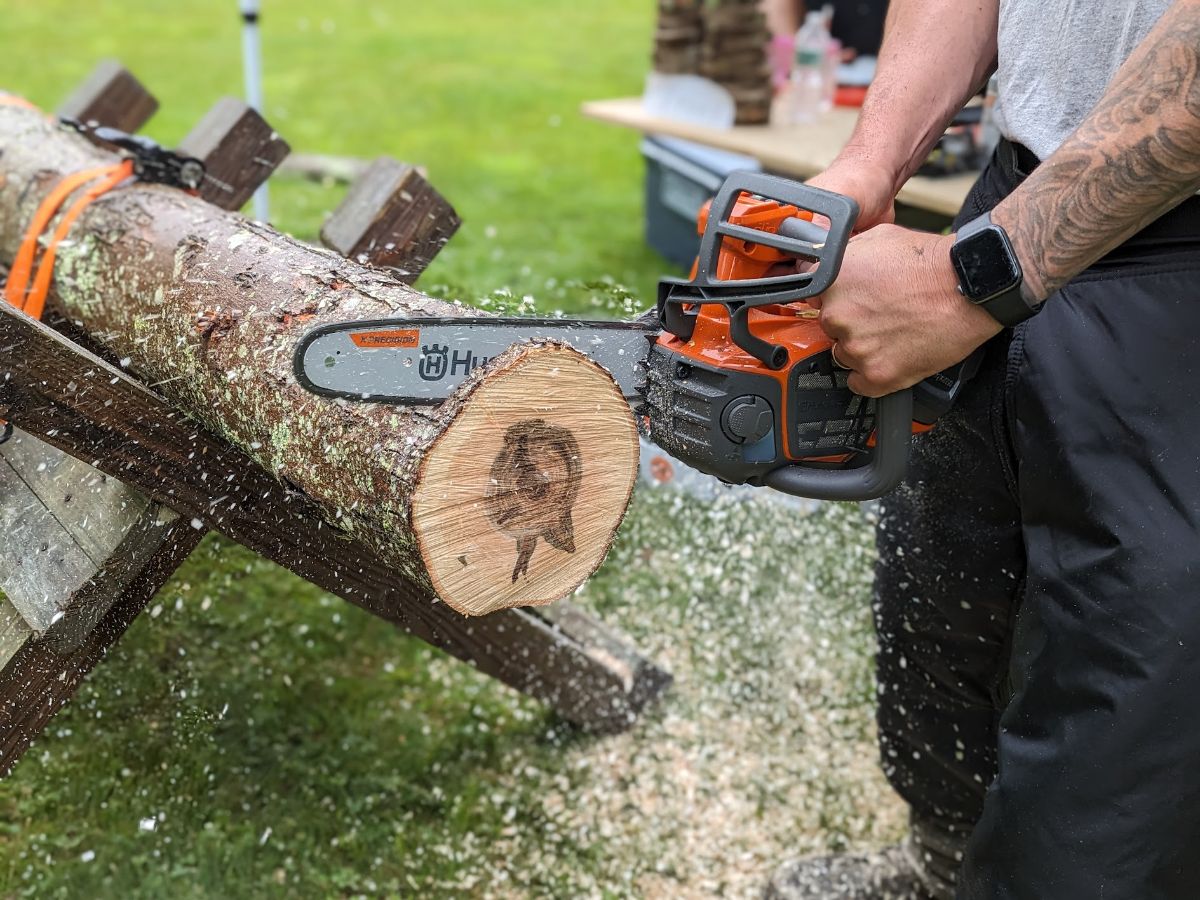
The Stihl was absolutely unstoppable. The saw’s heavier weight and powerful battery system allowed the saw to rip through both tests. This test also demonstrated the capabilities of the new Makita XGT platform compared to the legacy Makita 36V saw. The XGT platform provided constant speed and power throughout the trial.
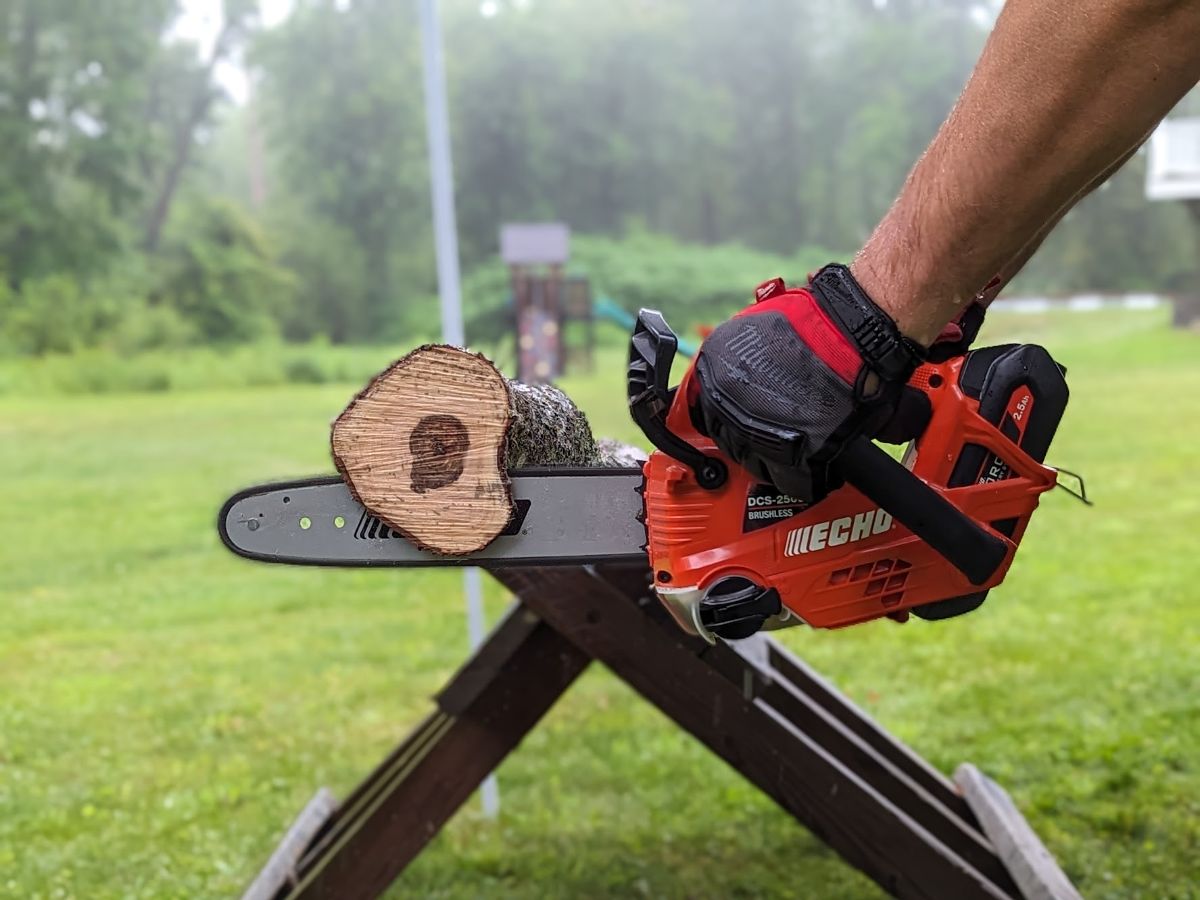
The Echo was the smallest saw we tested and lagged behind in both tests by a substantial margin.
Weight
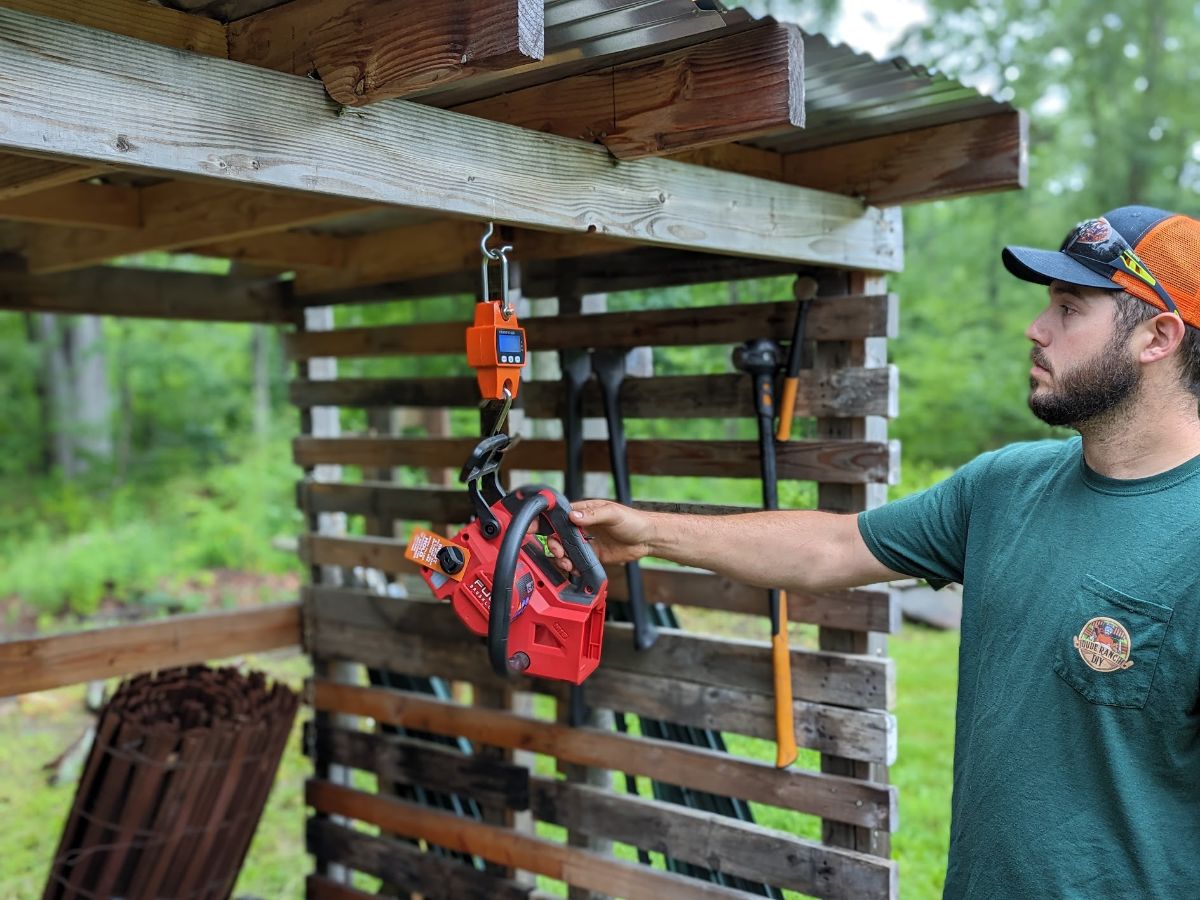
Weight is a huge factor to consider when selecting a top-handle saw. By design, these tools are meant to be used at adverse angles and uncomfortable positions. A tree care pro may use one of these saws at shoulder height or above for hours at a time. Therefore in order to paint the complete picture of what each of these saws weighs, we took two measurements.
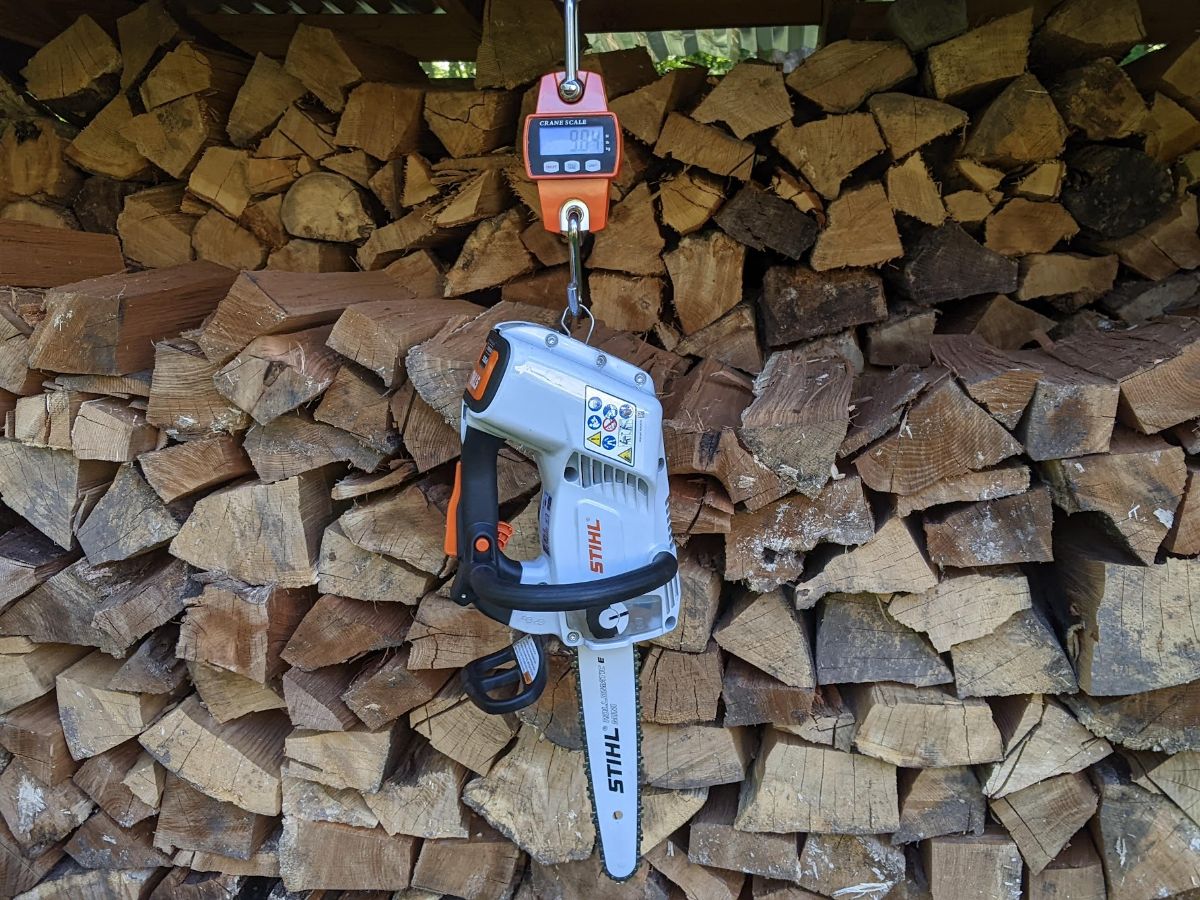
The first was the bare power-head weight. We weighed each saw with an empty bar oil reservoir and removed the bar and battery. Then we attached the bar and chain, filled the oil reservoir, and inserted a battery. We ranked the tools based on the fully assembled weight but thought that the bare powerhead weight and subsequent increase in weight was a good data point to collect.
The lightest assembled saw was the Echo at 7.46 Lbs. Second place went to the Stihl MSA161T at 9.84 Lbs. and third place to Husqvarna at 10.16 Lbs. The heaviest assembled saw was the Stihl MSA220TC at 12.38 Lbs.
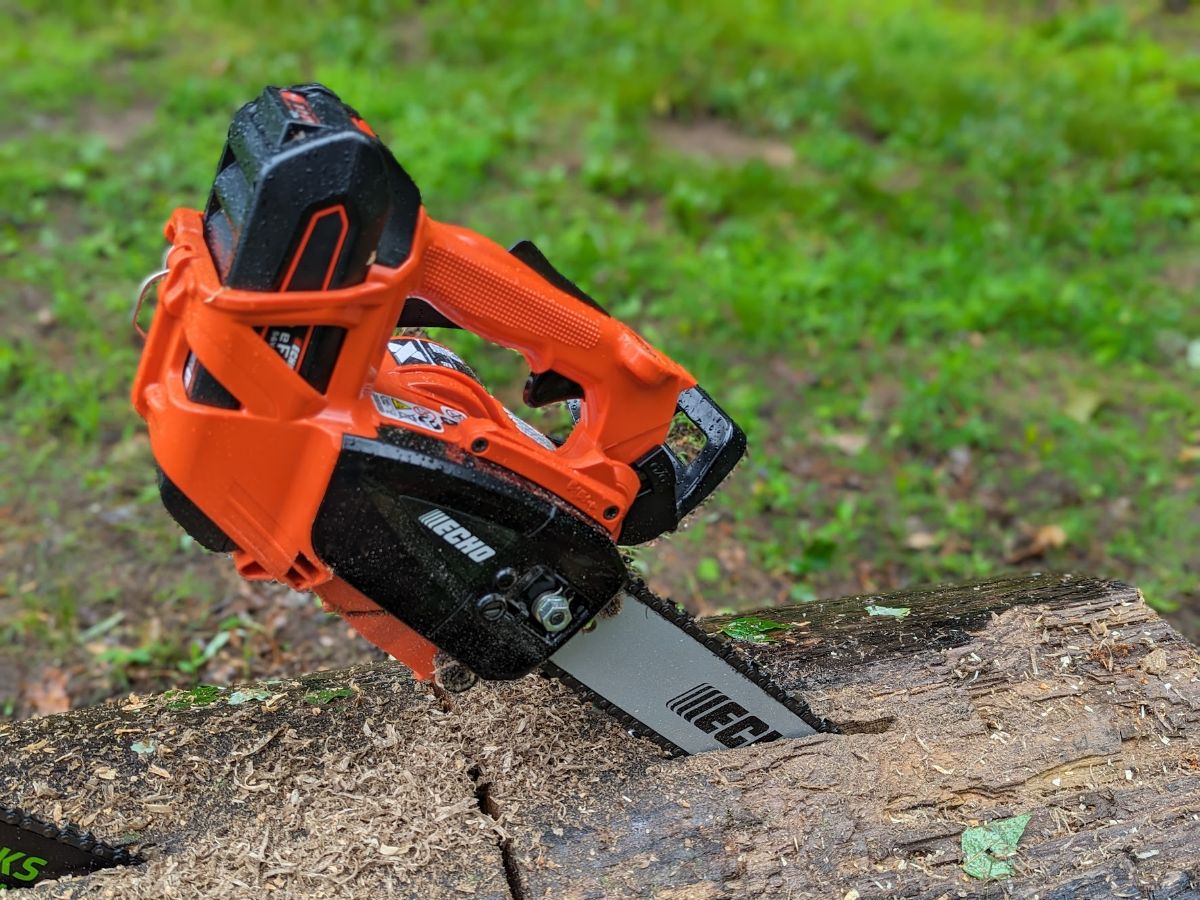
The Echo is an incredibly light saw in the hand at under four pounds as a powerhead. Even fully assembled the Echo is almost as light as the Milwaukee powerhead. On the opposite end of the spectrum, the Stihl MSA2210TC powerhead is about one pound heavier than its gas counterpart the MS201T.
Decibel Output
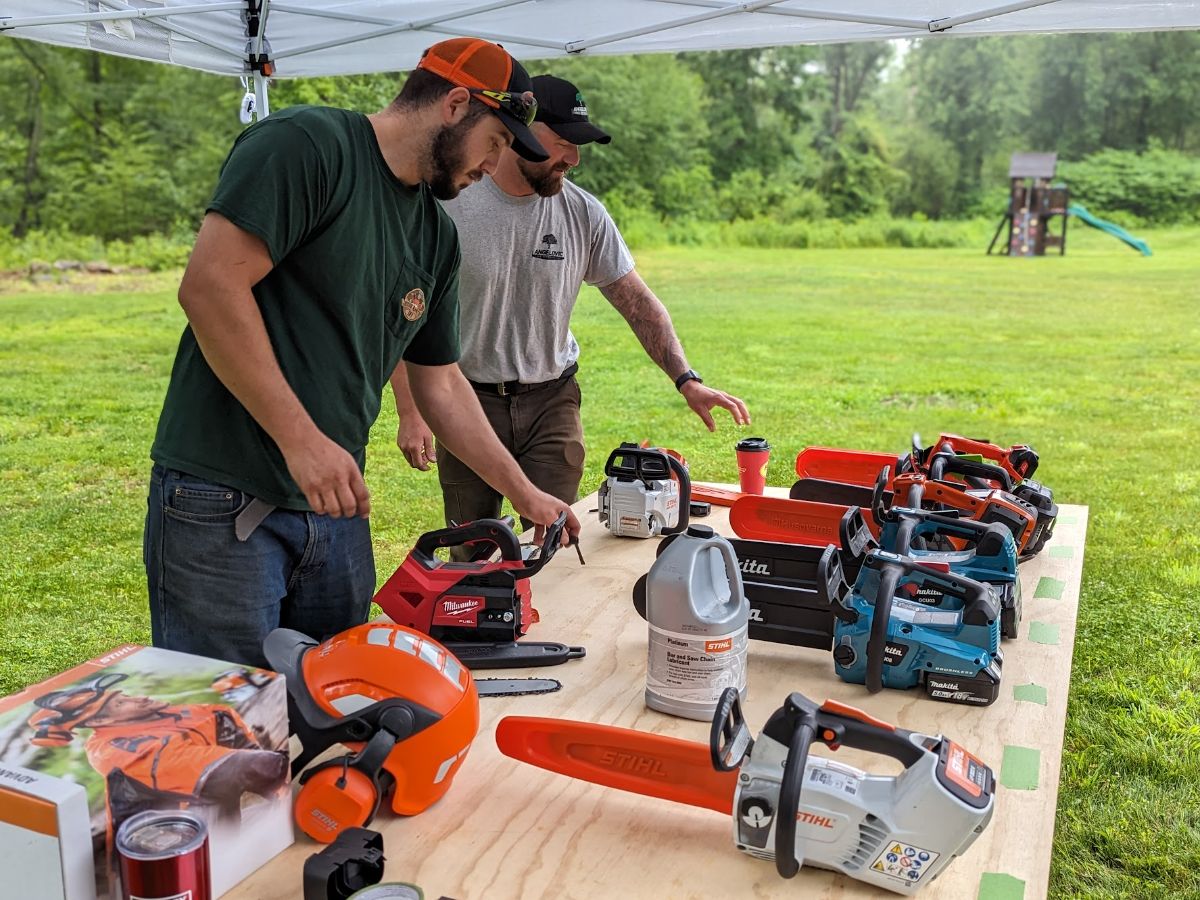
The level of received noise at the ear is a concern for the longevity of all professionals. According to OSHA standards, any exposure for eight hours of 85 decibels or higher requires hearing protection. In order to measure the noise output of each saw, we placed them on a jig with a decibel meter placed in a designated location to measure noise output. We then ran each saw for ten seconds at full speed, while not under load, and recorded the decibel range.
The quietest saw was the Stihl MSA161T at 80.8 decibels. This was the only saw that was under the 85-decibel threshold as well. Second place was Milwaukee at 91.3 decibels and third place went to Husqvarna at 92.4 decibels. The loudest saw tested was the Makita XGT at 100.9 decibels.
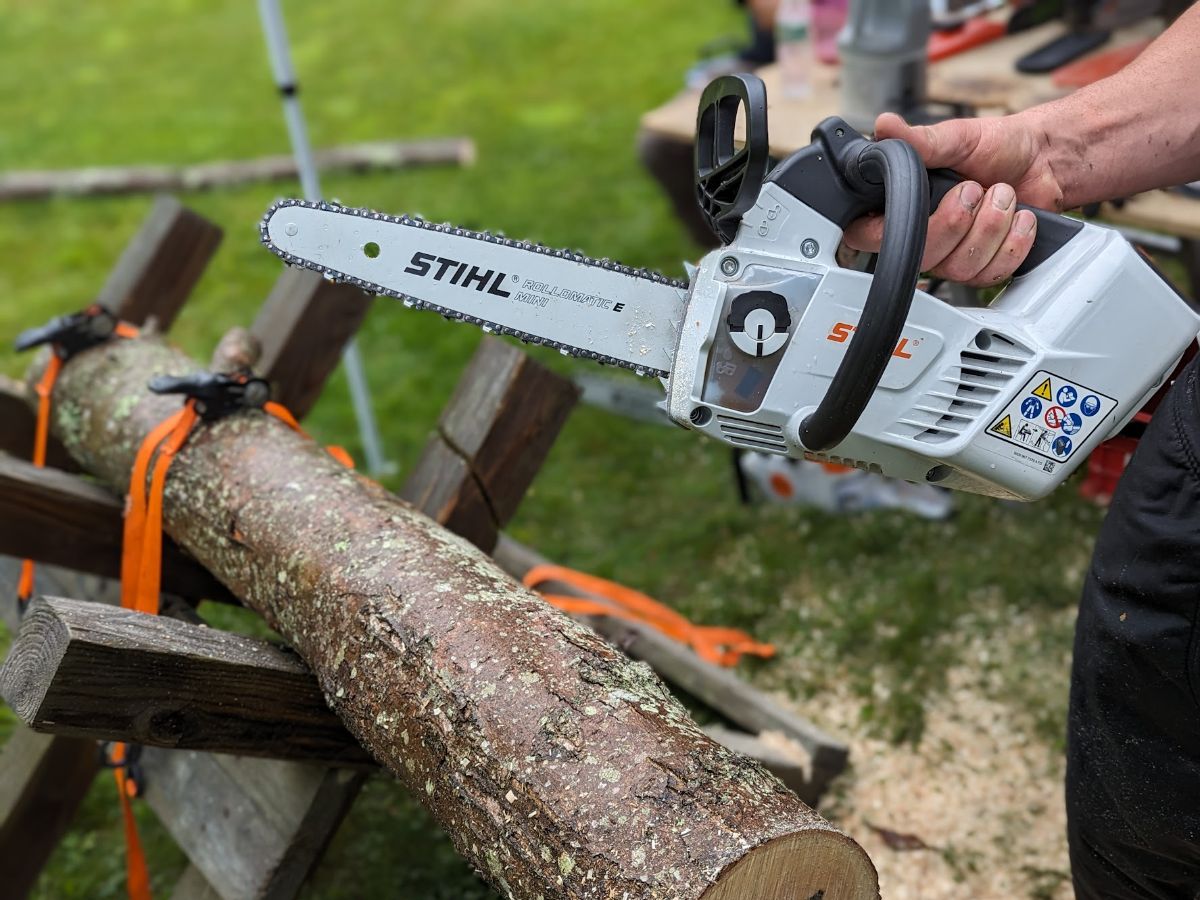
An interesting field note from our pro-user testers was that decibel ratings were really not a concern to them. They all wear helmets with built-in hearing protection and radio capabilities for communicating with their ground guys. However, the lower decibel output of all of our battery saws, compared to their gas counterparts, can be beneficial when working in areas with noise-based work hour restrictions, such as residential neighborhoods.
Price
For this H2H we chose to rank the tools based on a kit price. While carpenters, plumbers, and electricians, are likely loyal to a battery platform and heavily invested, the same cannot be said of most tree care pros. A tree care pro is likely buying a battery top handle saw for the first time and has no other tool that runs on that platform. Therefore we chose to select a kit option for the price ranking that includes the battery we used during testing.
The winner of the price rankings is a tie between Greenworks Commercial and Milwaukee. As of July of 2023, both companies are offering a kit with battery and charger for $499.99. In second place is Echo at $549.99 and third place is the Makita 36V at $579.00. Our most expensive saws are the Husqvarna at $1,049.00 and Stihl MSA220TC at $1,169.97 as kits.

While price is important to all users, we chose to not include it when determining our final rankings.
Features
Our entire saw lineup featured outstanding professional-grade features. For instance, all eight saws included manual chain tension adjustment systems. This traditional, tooled, style of adjustment is our preferred method due to its robustness. In order to determine which saw had the best set of features, we outlined nine total evaluation criteria. We then ranked each saw’s feature on a scale of one to three, with three being the best. The saw’s total overall score was used to determine rank. Our evaluation criteria are as follows;
- Felling Spikes
- Chain Brake Contour/Response
- Lanyard Ring(s)
- Electronic Chain Brake
- Automatic Oiler
- Manual Chain Tensioner
- Additional Modes
- Standout Features
- Safety Auto Shut-Off
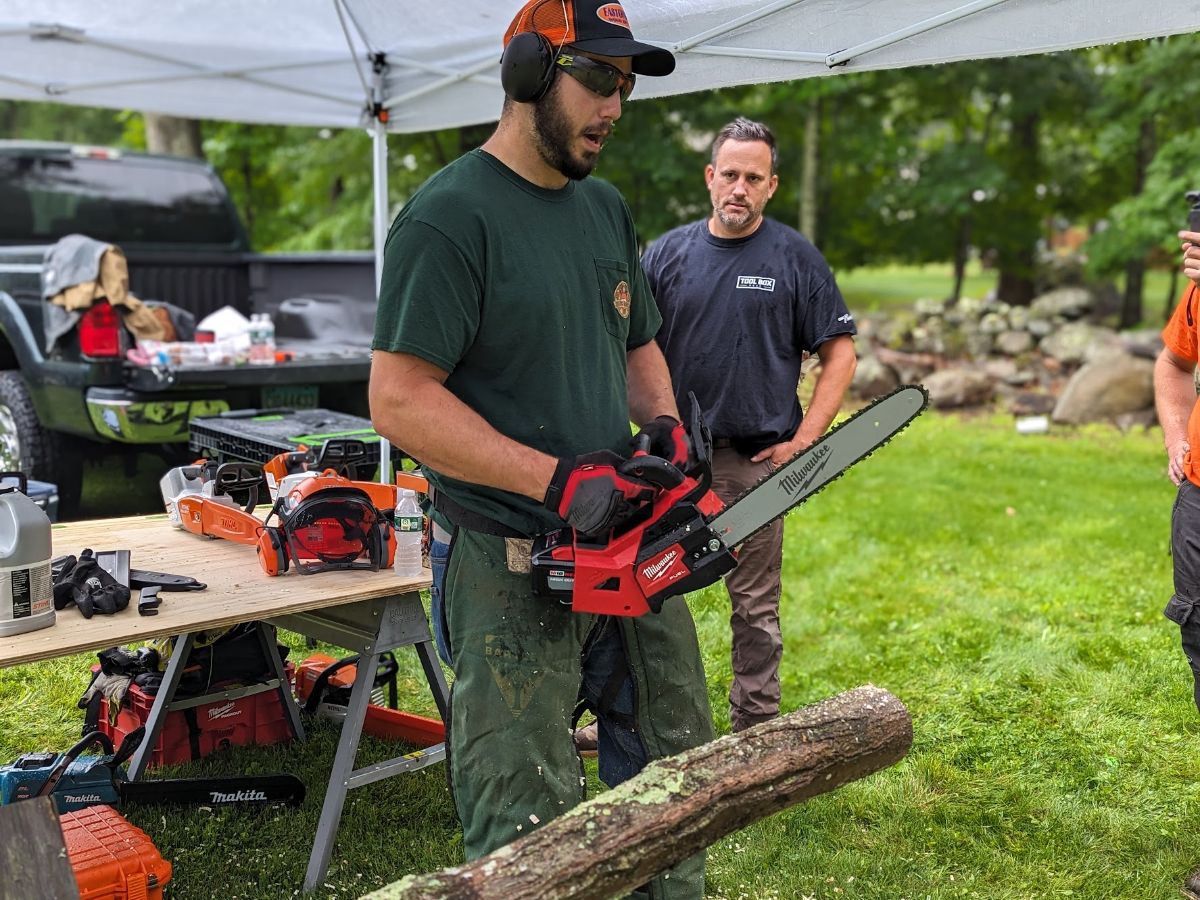
The saw with the best features is the Milwaukee. The M18 saw has outstanding aggressive felling spikes as well as a large manual chain brake lever that is responsive and has a very positive click action. The steel lanyard ring is in a great position and locks in the open position. It has a very responsive electric chain brake and the chain tensioner features an extra bar stud to lock the mechanism in securely. Our crew agreed that an automatic oiler system is their preferred option, but Milwaukee’s manual adjusting oiler performed well in the highest output setting. The Milwaukee is also the only saw with an onboard saw wrench or “scrench”. While not an absolutely mandatory feature, it is a nice bonus.
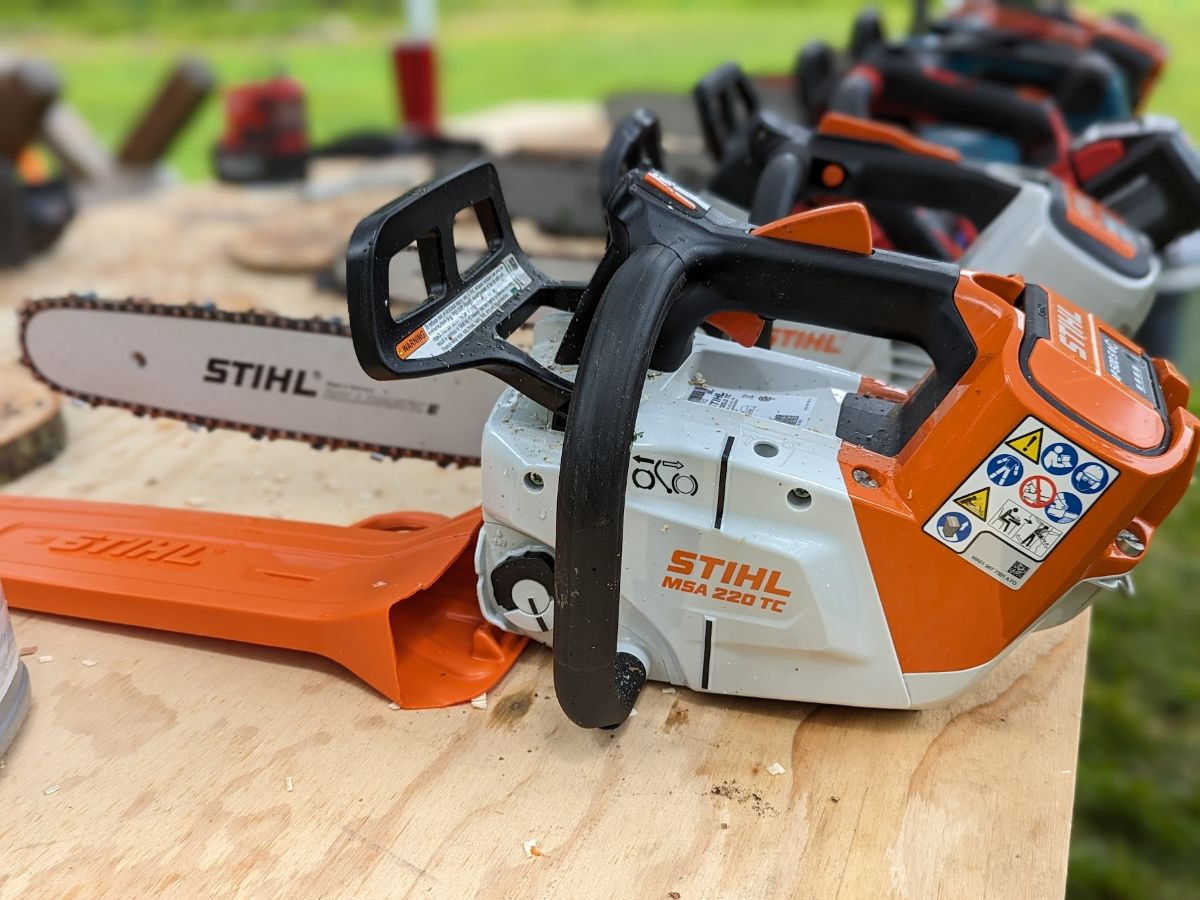
Second place went to the Stihl MSA22oTC-O, which has an outstanding billet of professional-grade features. In fact, the “O” designation in the Stihl’s name refers to their electronic bar oil monitoring system. The saw will monitor the flow of bar oil via an internal laser. The system also monitors for dirt and contaminants. When the oil is low or full of debris, a light will activate on the saw’s main control panel to alert the user. This feature was unlike anything our testing crew had seen before.
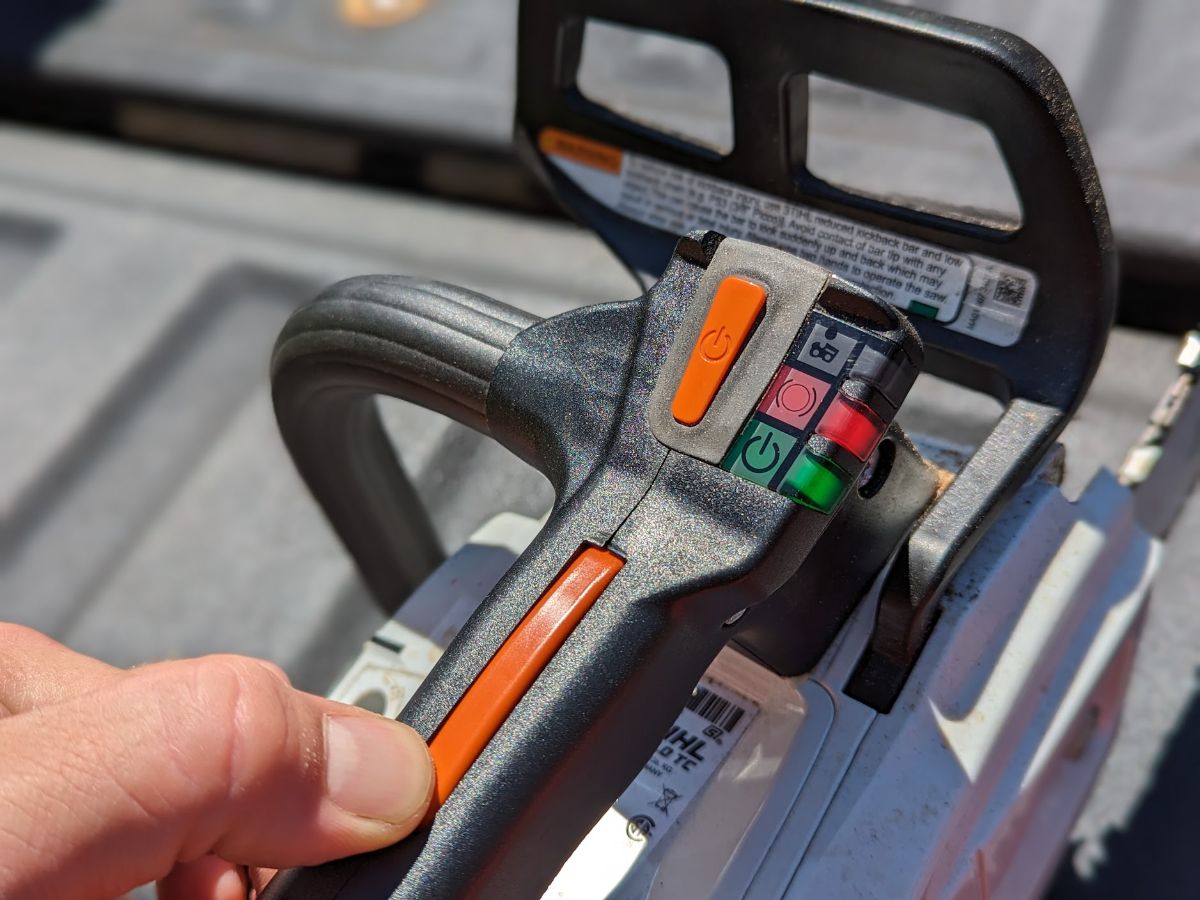
Where Milwaukee excelled over the Stihl to our crew was with the different safety auto shut-off systems. The Stihl has a push-button activation switch to turn the saw on and off. There is also a warning light to alert the user when the chain brake is turned off as well as a tang safety in the top of the grip that must be depressed. Once the user releases that tang safety, with the chain brake off, the saw shuts off in about five seconds. This was a real annoyance to our crew during testing and our pro users agreed that this was too fast. Conversely, the Milwaukee uses a spring-loaded tang safety in the grip with no additional on/off switches. It is intuitive to use and ruggedly simple. Our pro-user crew agreed that Milwaukee’s system would be more user-friendly and productive for them.
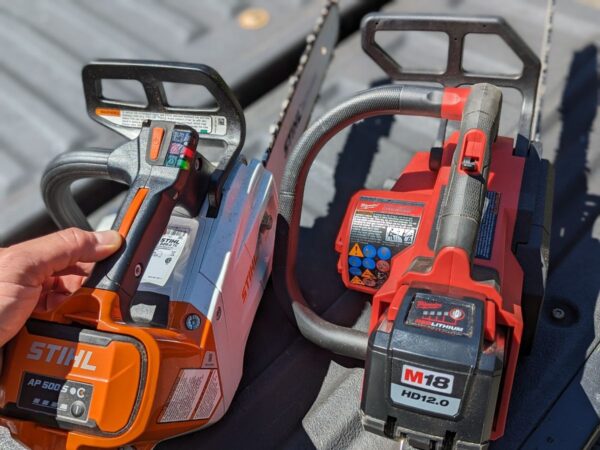
Third place resulted in a tie between the Echo and Husqvarna saws. The Echo is an extremely lean-built saw and doesn’t have many extra bells and whistles. It lost points due to the shorter felling spikes but has a simple and excellent push-button activation switch. The Husqvarna features an excellent digital battery display at the activation switch to show power consumption in real time as well as an Eco mode for battery conservation. However, the Husqvarna chain tensioning mechanism makes it difficult to get seated properly when removing the clutch cover and changing bars and chains. Twice the Husqvarna saw chain completely slacked out during our test cutting. We experienced the same issues in our 2020 Head-2-Head testing.
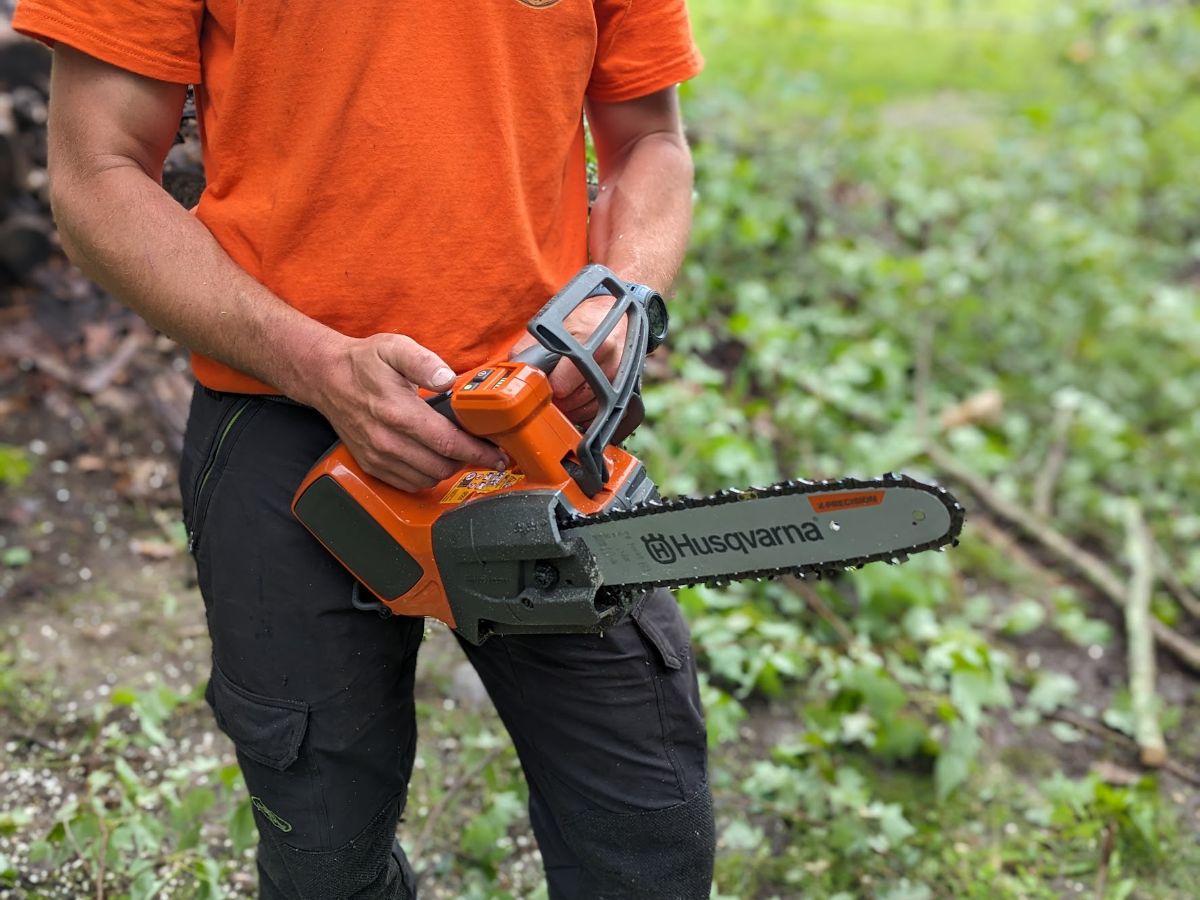
Rounding out the category, the Makita 36V saw has an impressive feature set, including a high-performance “Turbo” cutting mode. But the mode is difficult to switch back and forth from. The Makita XGT lacks some of the additional features of the legacy 36V saw, but both offerings have excellent felling spikes and chain brake designs. The Greenworks Commercial and Stihl MSA-161T had very basic features compared to the rest of the test sample. The Greenworks saw lost points due to having rounded felling spikes that did not grab into our cutting materials during testing as well as a confusing power activation button.
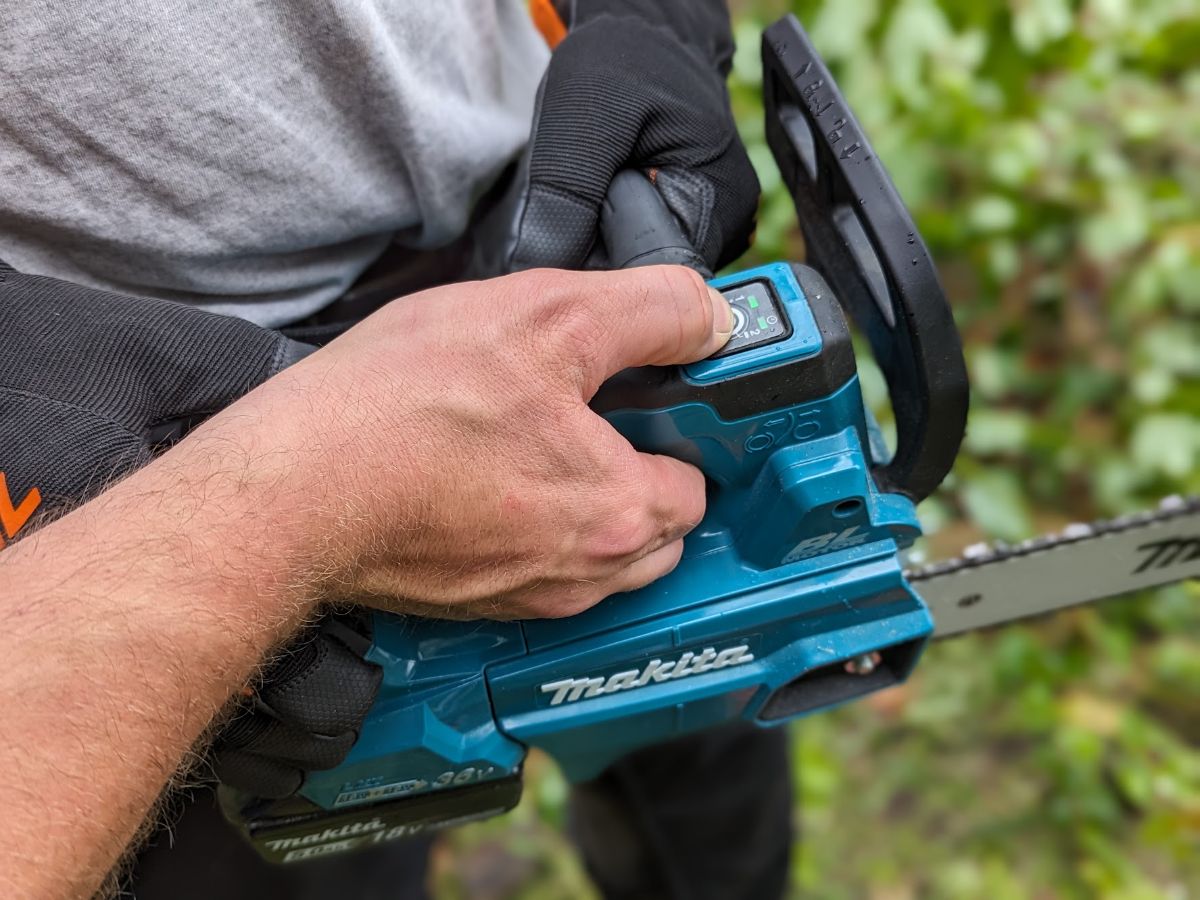
Ergonomics
Ergonomics is one of our most subjective categories, but is one of our favorite and most discussed evaluations. If a tool is not comfortable or works against the user in any way, it is almost worthless. Similar to our Features section, we chose a total of six evaluation criteria to rank our battery top-handle chainsaws. The ergonomics of a top-handle saw are critical to a pro user in the field when working in the air, wearing gloves, or working in inclement weather. That is why we selected the following categories for evaluation;
- Grip Comfort
- Grip Contour
- Forward Handlebar Angle
- Bar Oil Fillcaps
- Weight and Balance
- Ease of Battery Change
The winner of this section is a three-way tie between Echo, Makita XGT, and the Stihl MSA-220TC. All three saws featured well-contoured and comfortable grips. The texture on all of them is excellent and all of the controls are easy to reach with one hand. The forward handlebars are also out of the way but easy to reach with an off-hand. Weight and balance were interesting with these models because they represent the best of our small, medium, and large offerings. The Echo is lighter and more compact, but both the Makita XGT and Stihl are compact in their overall design with no wasted space.
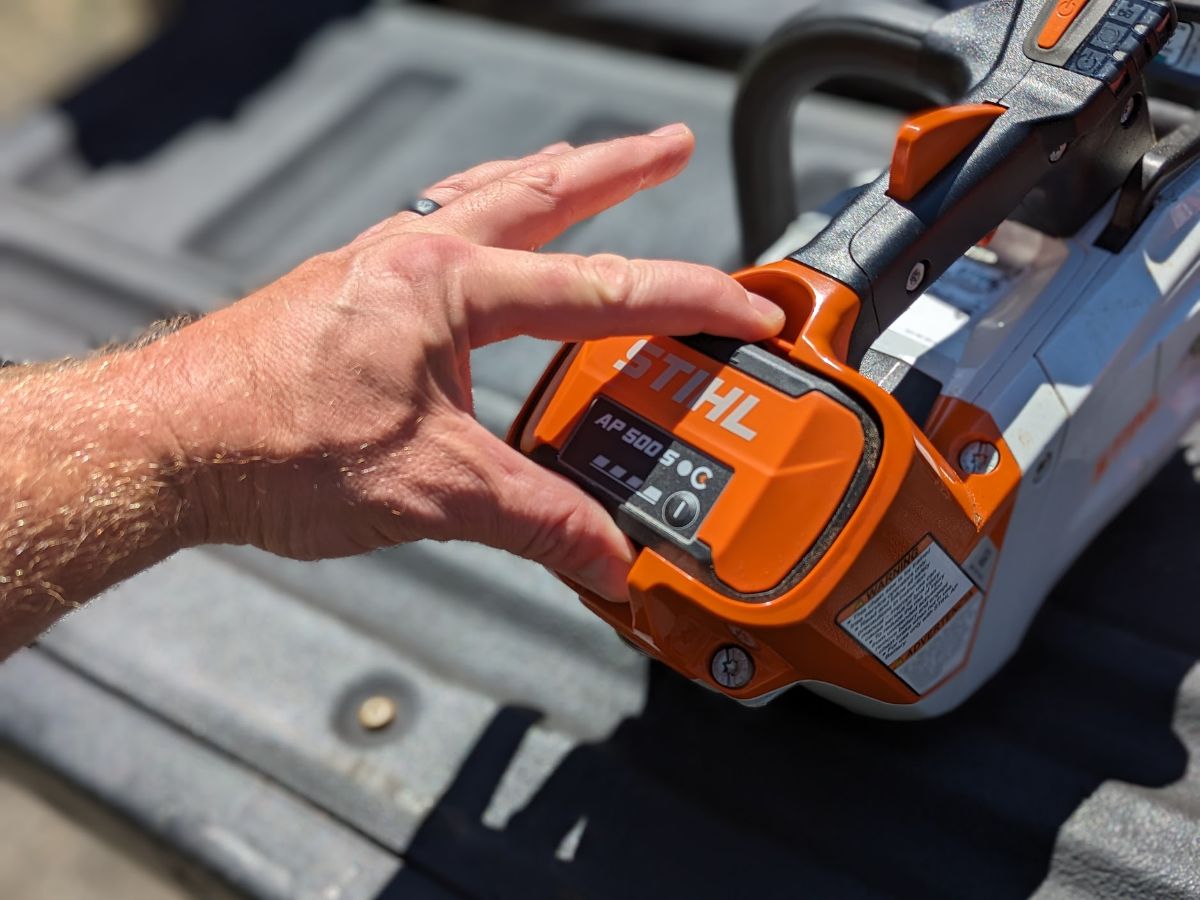
Although all three saws received the same overall score, the Echo had the best and most comfortable grip of the three as well as the nicest bar oil reservoir caps. However, the Makita XGT and Stihl have superior battery-changing mechanisms. The Stihl is the easiest to change batteries thanks to the battery being spring-loaded and inserted from the top of the saw.
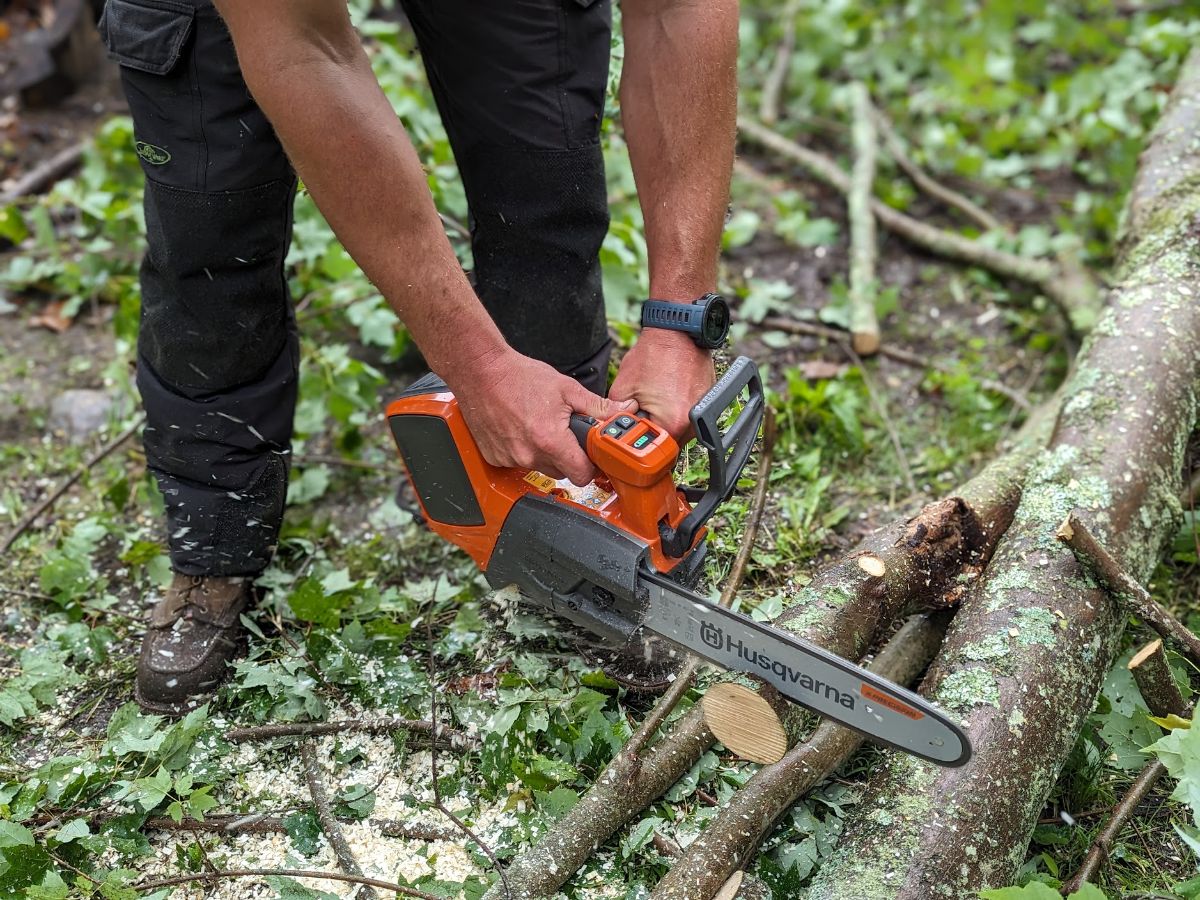
Husqvarna took second place in ergonomics for battery top-handle chainsaws with excellent weight and balance as well as very comfortable grip material and handlebar angles. The criticisms of the Husqvarna were that the chain brake lever is too close and can be cramped on the user’s hands. Additionally, the sliding tang safety on the top of the grip was awkward to all of our test cutters. The Milwaukee came in third place with excellent grip materials as well as the most room for your hands of all of the saws test. The Milwaukee is a very big saw though. It sacrificed compact size for more room and feels bulky compared to most of the other saws. The side handlebar of the Milwaukee also bows out further than any other saw and gives it a Beachcomber bicycle feel.
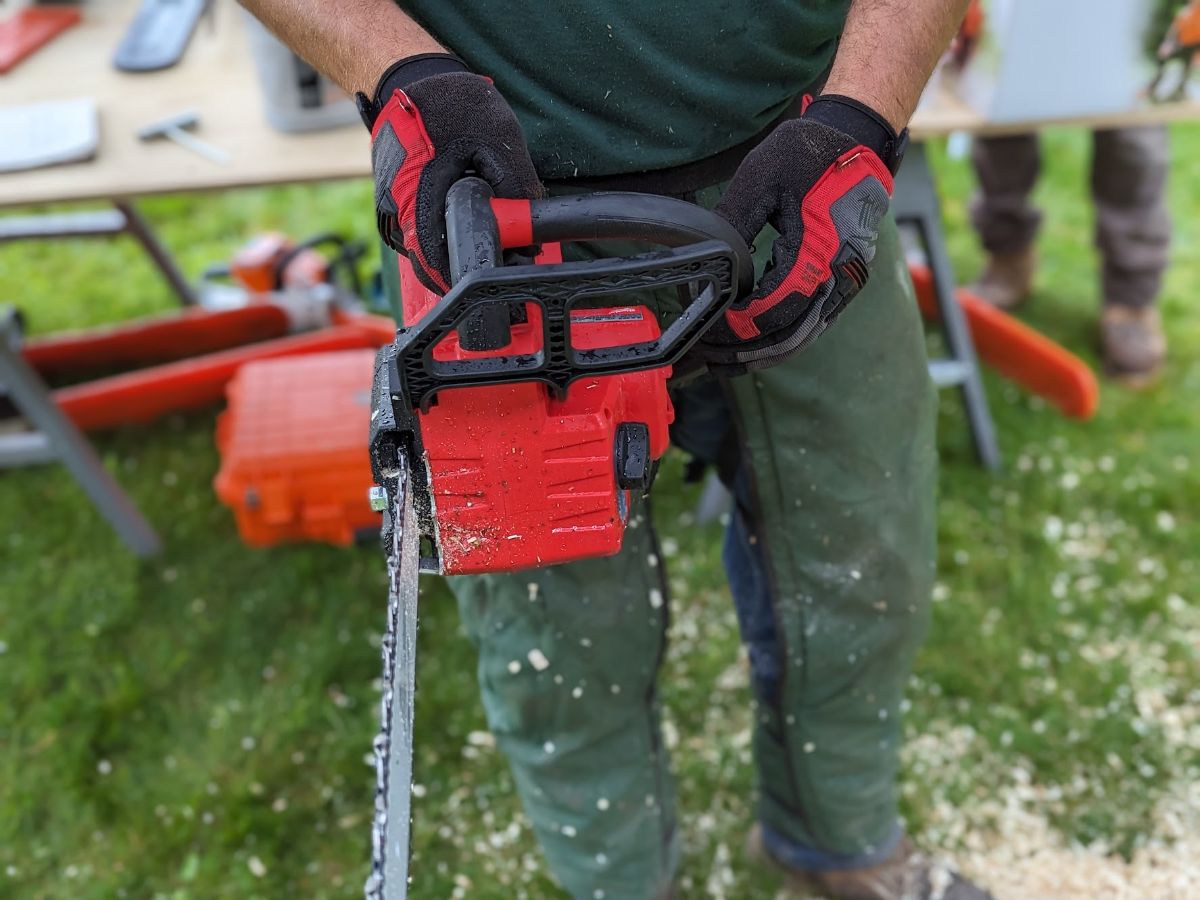
Finally the Makita 36V saw was bulky and more off-balance than its counterparts due to the two-battery system. While they are easy to change, managing two batteries was not something our test crew viewed as desirable. The triple manual grip safeties of the Stihl MSA-161T were our least favorite and seemed almost impossible to use, safely, for lefties. The Greenworks saw felt off-balance and the controls were cramped and on top of each other.
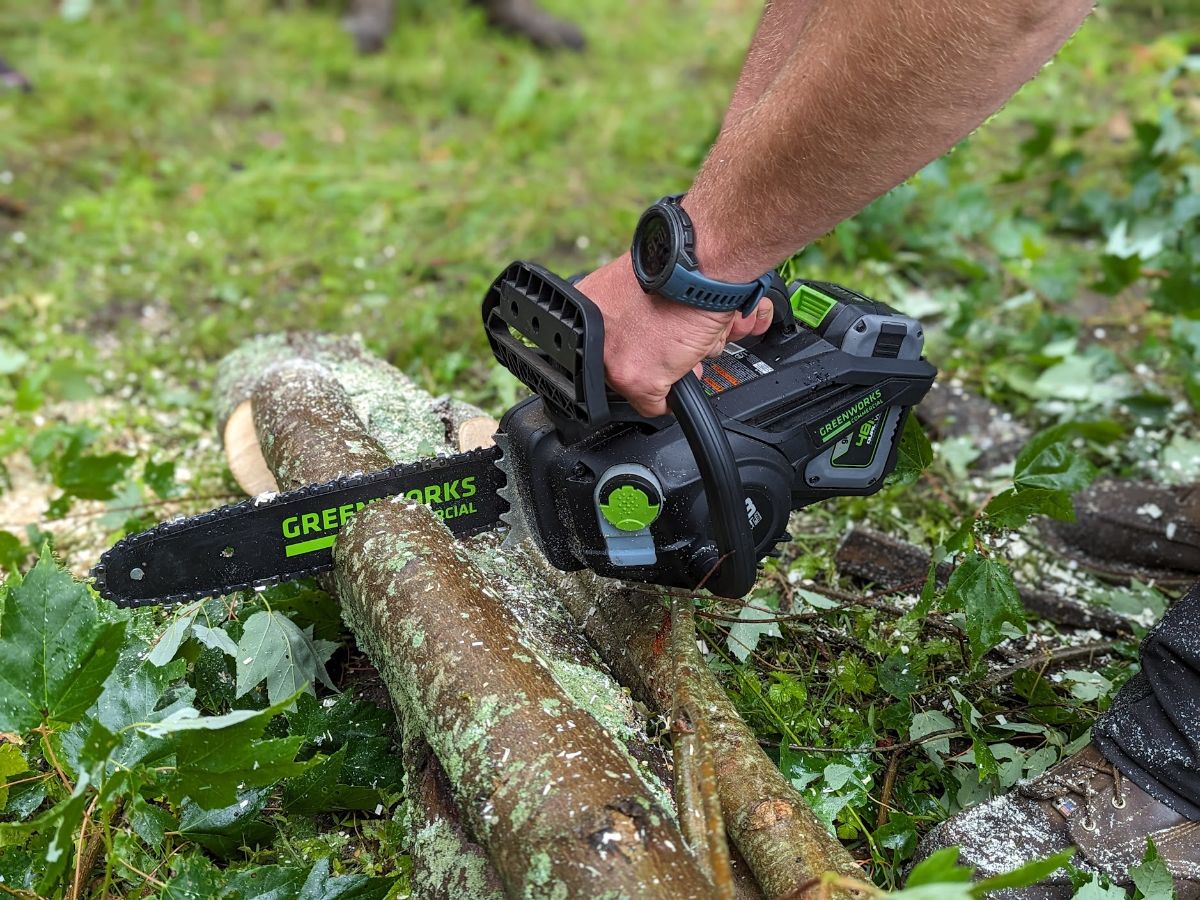
Best Value Battery Top-Handle Chainsaw
One of our favorite categories to name is the Best Value, especially when we are talking about a battery top-handle chainsaw. These are expensive tools and present pro-users with a large financial investment. So which saw gives the best performance while still remaining reasonably priced? It is hands down the Milwaukee M18 Fuel.
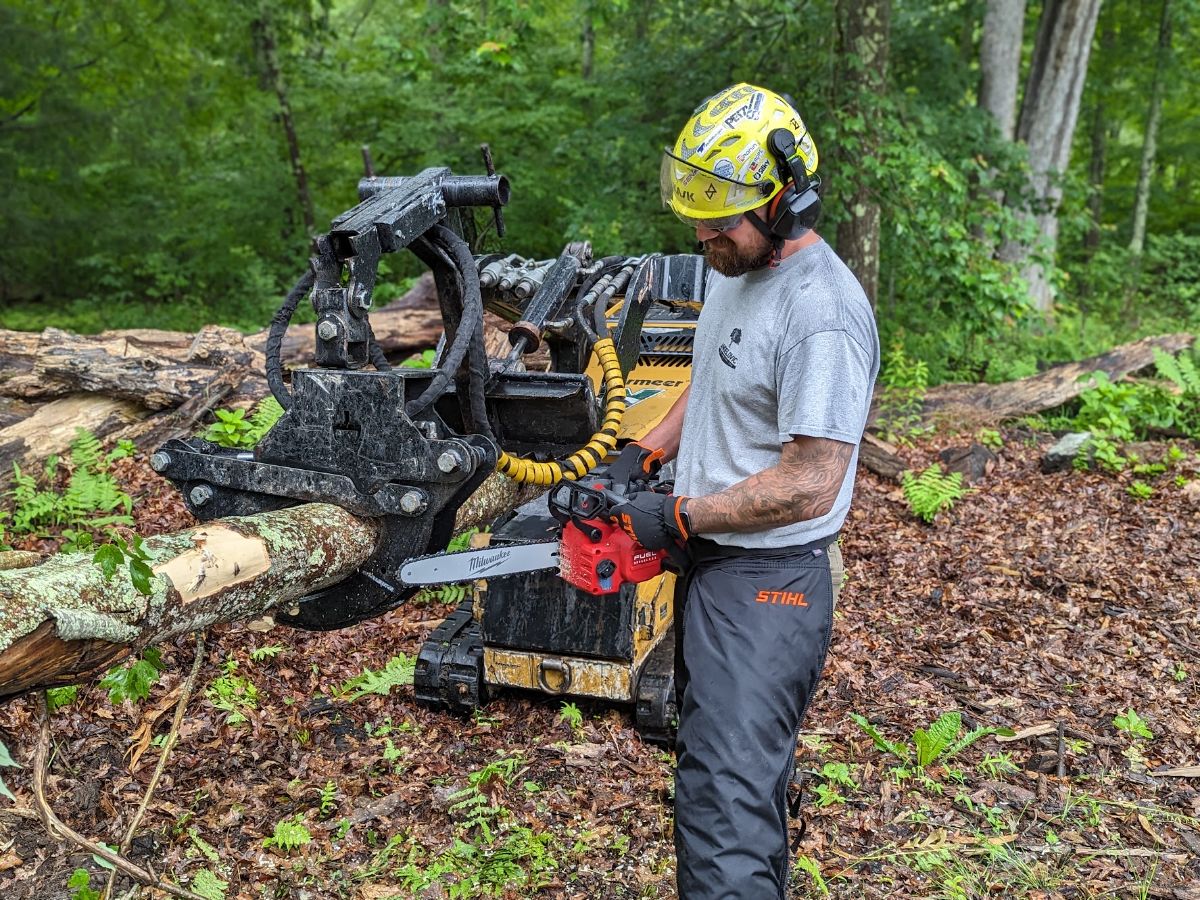
The Milwaukee battery top-handle chainsaw finished in the top three of every category except for weight. Additionally, it achieved a first-place finish in the features category while tying for first place in the Stall Out test. Furthermore, Milwaukee also tied the Greenworks saw as our most affordable saw tested.
Overall Best Battery Top-Handle Chainsaw
At the completion of our testing, all of the data we gathered on the saws was compiled. When then used this to create rank structures for every category and finally used those ranks to create an overall final rank structure. The saw with the lowest number of points in this final ranking structure was our overall winner.
With a final overall score of nineteen points, our best battery top-handle chainsaw is the Milwaukee M18 Fuel. The Milwaukee is ergonomic and powerful with well-thought-out features. The safety system on the M18 saw was also one of the most preferred designs by our test crew due to its simplicity and similarity to their traditional gas-powered saws. The Milwaukee is a large saw though and is heavy. Because of that, our pro users weren’t sure if it would be suitable for full-time climbing work. The fact that the Milwaukee battery platform is so widespread and commercially available is a nice bonus but was not a determining factor for our tree care pros.
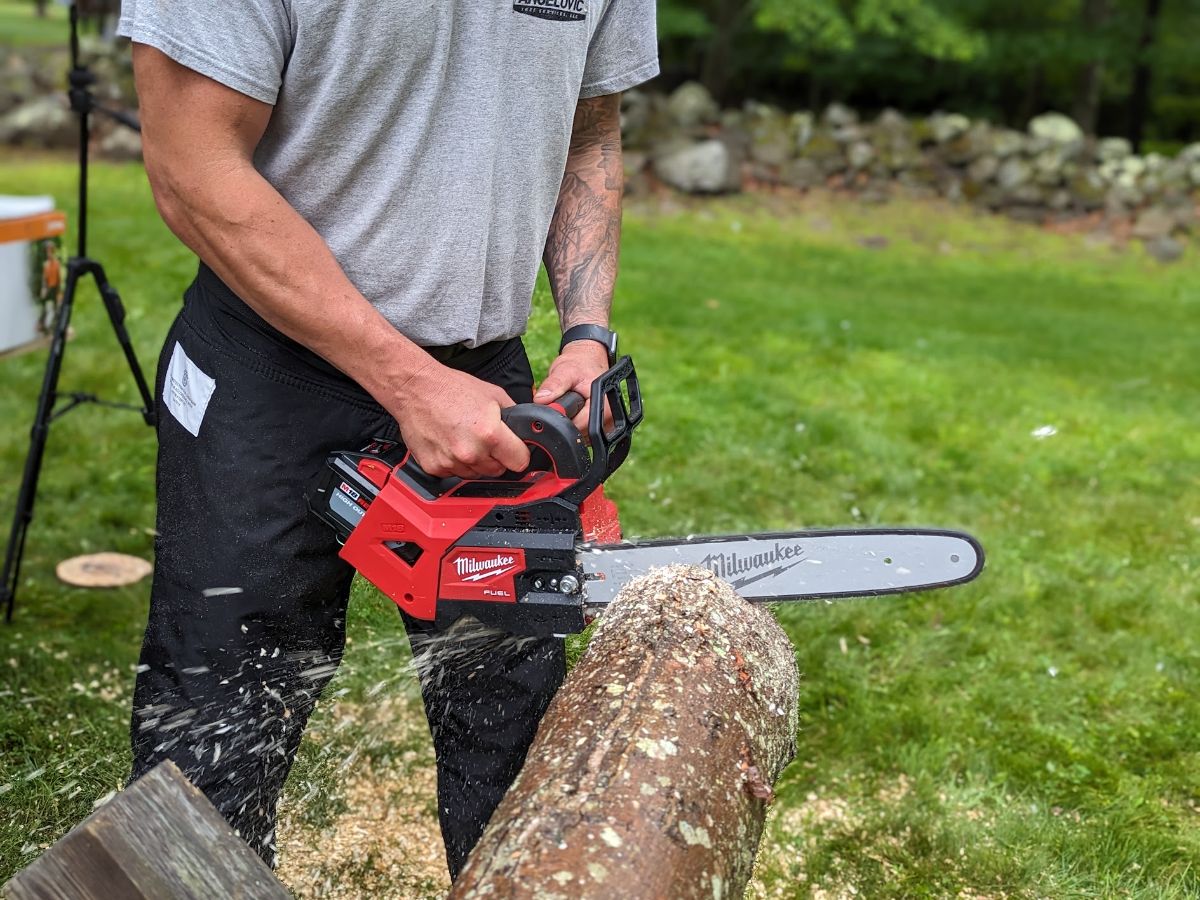
Second place was a tie between the Stihl MSA-22TCO and the Husqvarna. The two biggest names in the chainsaw world and both companies make an incredible battery-powered top-handle chainsaw. The Husqvarna has been on the market for several years now and has remained mostly unchanged. After testing it we realized that this is because Husqvarna got it right with the first generation. It is a fast, light, powerful, and nimble saw. The Stihl is brand new to the market and focuses more on raw power. We described the saw as “Beastly” earlier and that really is the best word for it. The Stihl is hands-down our top choice for demanding take-down work. Our test crew all greed that the Husqvarna and Stihl would be their top choices as tree care professionals and likely the only choices that would earn a coveted spot in their tree trucks due to the commercial warranties, dealer support networks, and overall reputation of both brands in the industry.
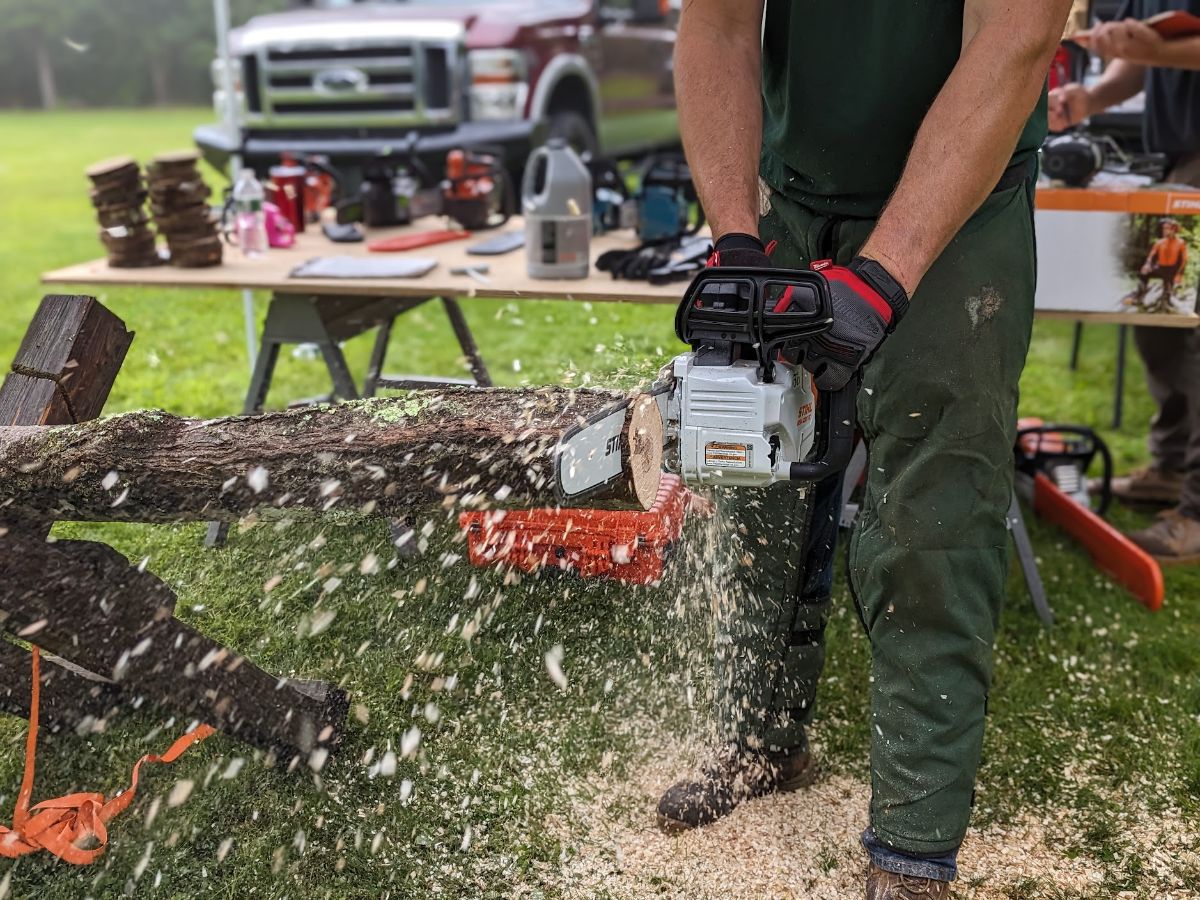
Third place went to the Stihl MSA-161T which shares many of the same perks as its younger, but bigger, brother. However, the MSA-161T has a proprietary bar design and uncommon chain size that make it less desirable. Stihl also does not do online sales, even for parts, making it more difficult to source these bars and chains.

All smiles!
The Makita XGT took fourth place overall. Showing that it is a product-improved version of the legacy Makita 36V saw. The improved battery technology and electronics of the XGT platform make for a saw that is really enjoyable to cut with. The legacy Makita and Echo tied for fifth place. The Echo struggled in our performance cutting tests but was a crew favorite thanks to its lightweight, great ergonomics, and professional-grade features. For smaller-diameter cutting tasks, the Echo is definitely worth a look. The Greenworks Commercial came in sixth place overall. While powerful, our crew agreed that it lacked some of the features and ergonomics they want in a saw.
Final Thoughts
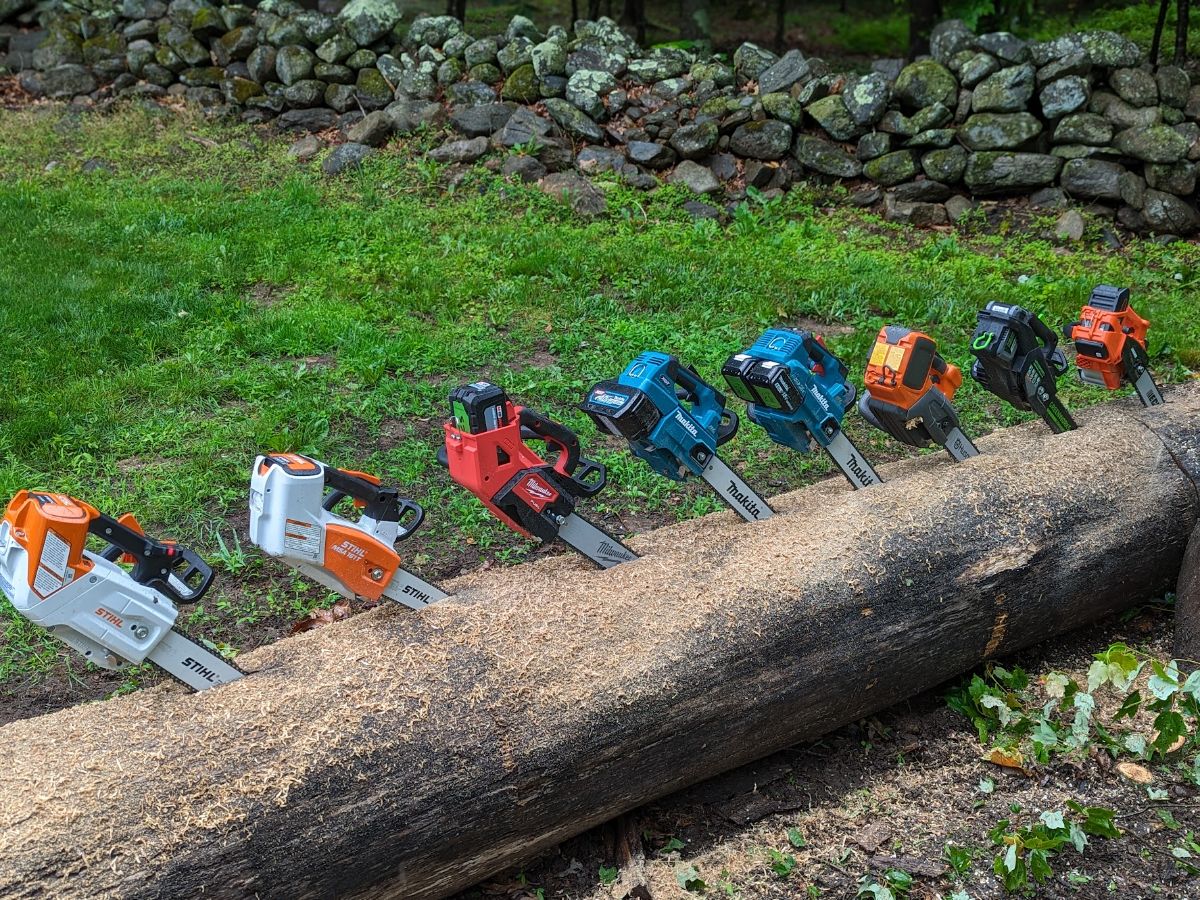
Overall our test crew was impressed by the evolution and capabilities of all of the battery top-handle chainsaws tested. The saws discussed above are true professional-grade tools and are capable of performing a variety of tasks common with the Arborist and tree care industries. We would strongly encourage any user out there considering a battery-powered option to give it a chance. The ease of battery-powered electric motors versus traditional gas-powered engines is well discussed and documented. They make for an exceptional user experience and will only get better with time.
If you are interested in purchasing any of the saws mentioned in this article, please check out our Buy Now links listed below. These links will bring you to some of our preferred industry partners such as ACME Tools. Additionally, you can find Echo, Husqvarna, and Stihl battery-powered OPE at your local outdoor power equipment dealerships.
Buy Now From Our Sponsored Retailers
Other Options
Best Battery Top Handle Chainsaw Head-To-Head Video
About the author
1 Comment
Leave a comment
Disclosure
Product reviews on this site contain our opinion of a product or service. We will always strive for objectivity and transparency in our reviews. Our goal is to provide readers with honest, objective information based on our own experiences. We never have and never will accept payment in exchange for a positive review. Many of the products that we review are provided to us for free by a manufacturer or retailer. In some cases, we also have advertising or affiliate relationships with manufacturers and retailers of products and services we review. For additional information please visit our additional disclosure policies.











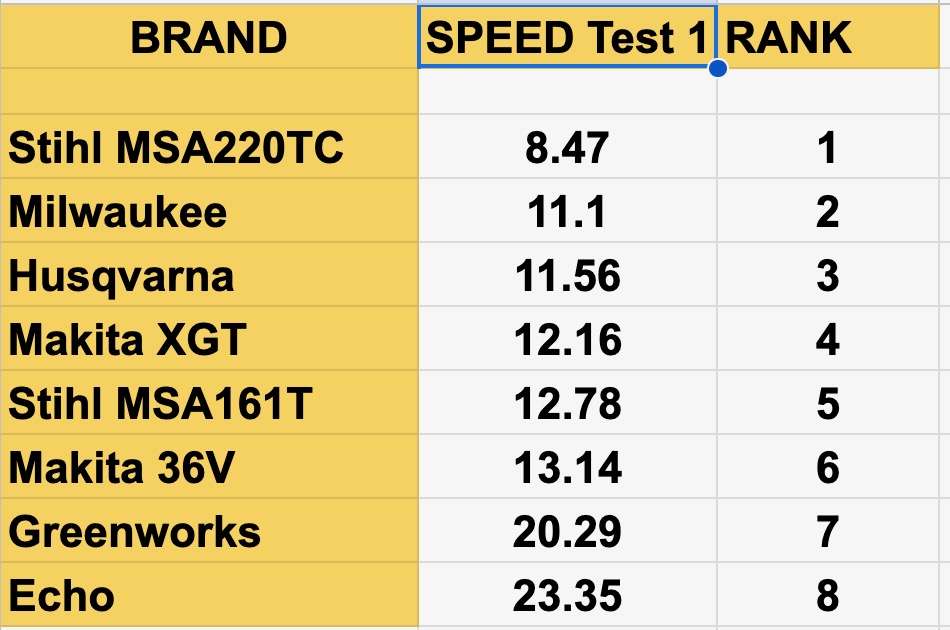
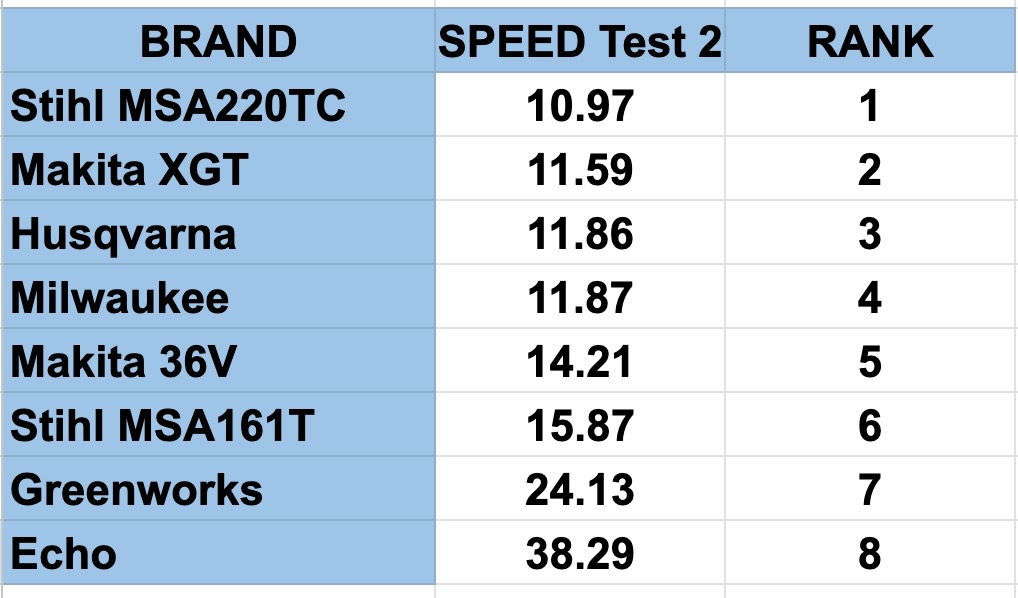
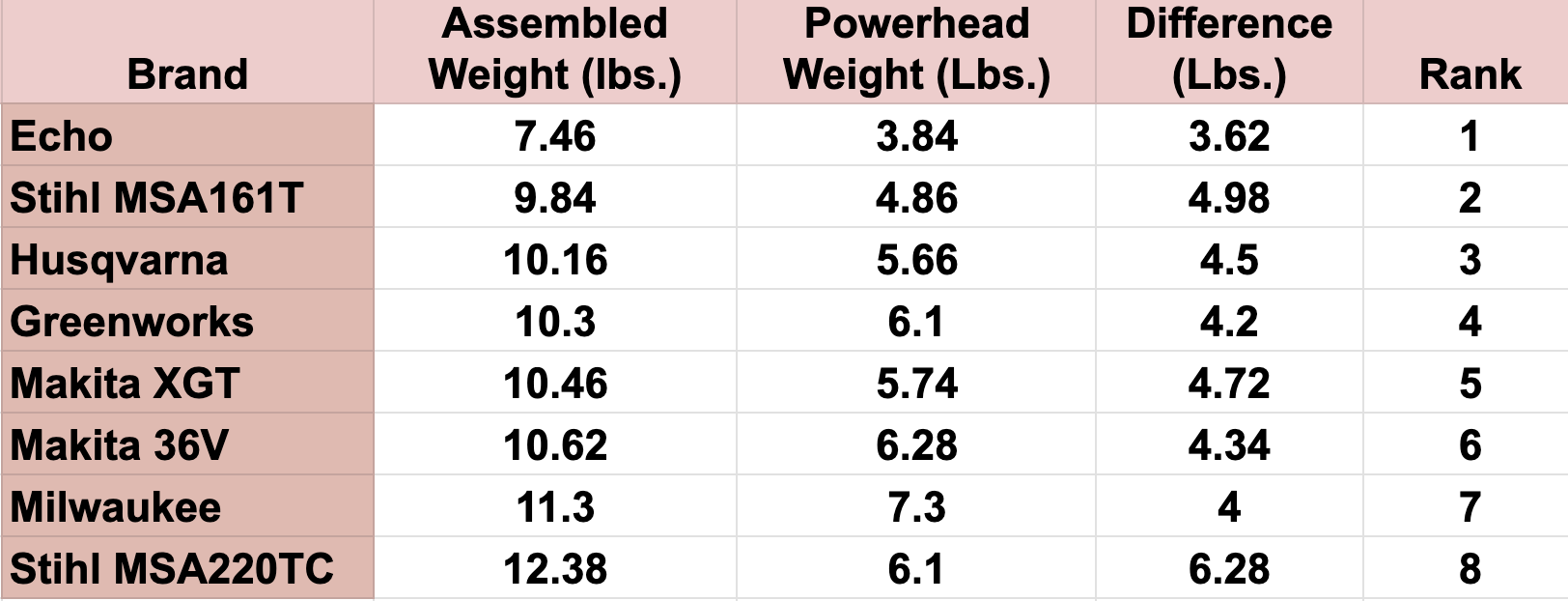
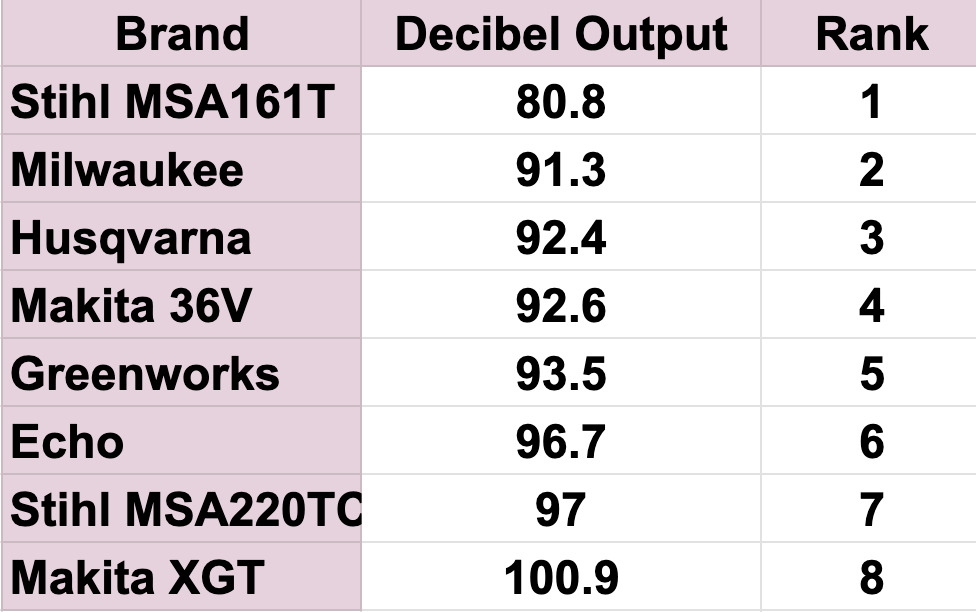
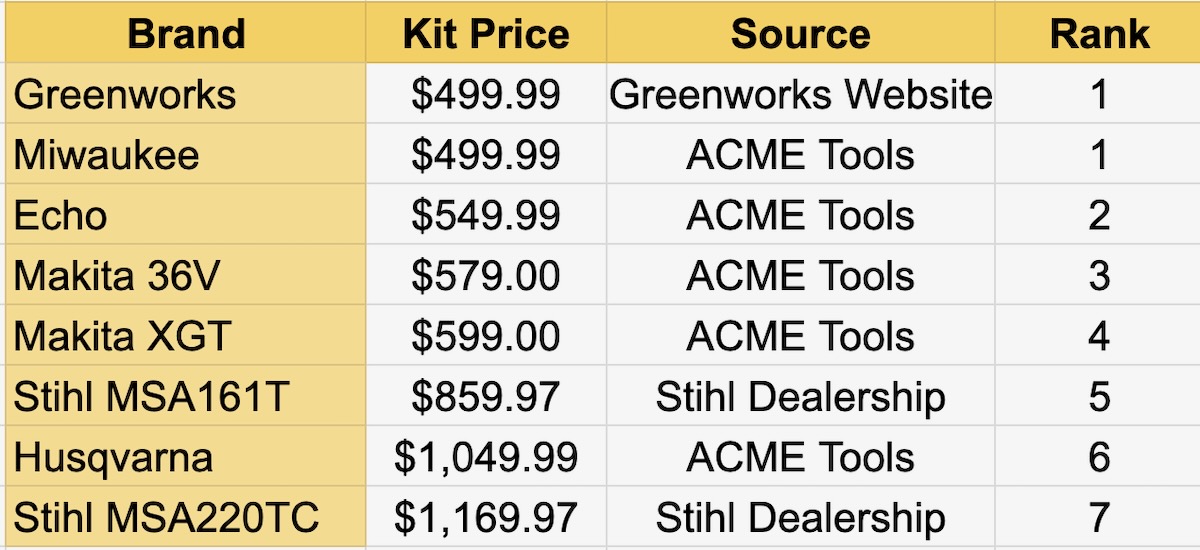

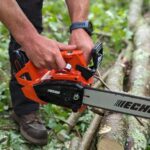
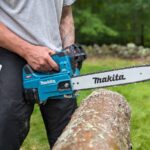
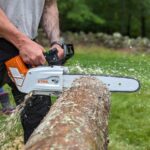














[…] our recent Best Top-Handle Chainsaw H2H, we discussed proper cutting techniques with a battery chainsaw. Allowing the saw to cut at its own […]